
ROLLING WITH ROLLING WITH


ROLLING WITH ROLLING WITH
RAW WISDOM FROM THE KING OF CANNA-CULTURE
RAW WISDOM FROM THE KING OF CANNA-CULTURE

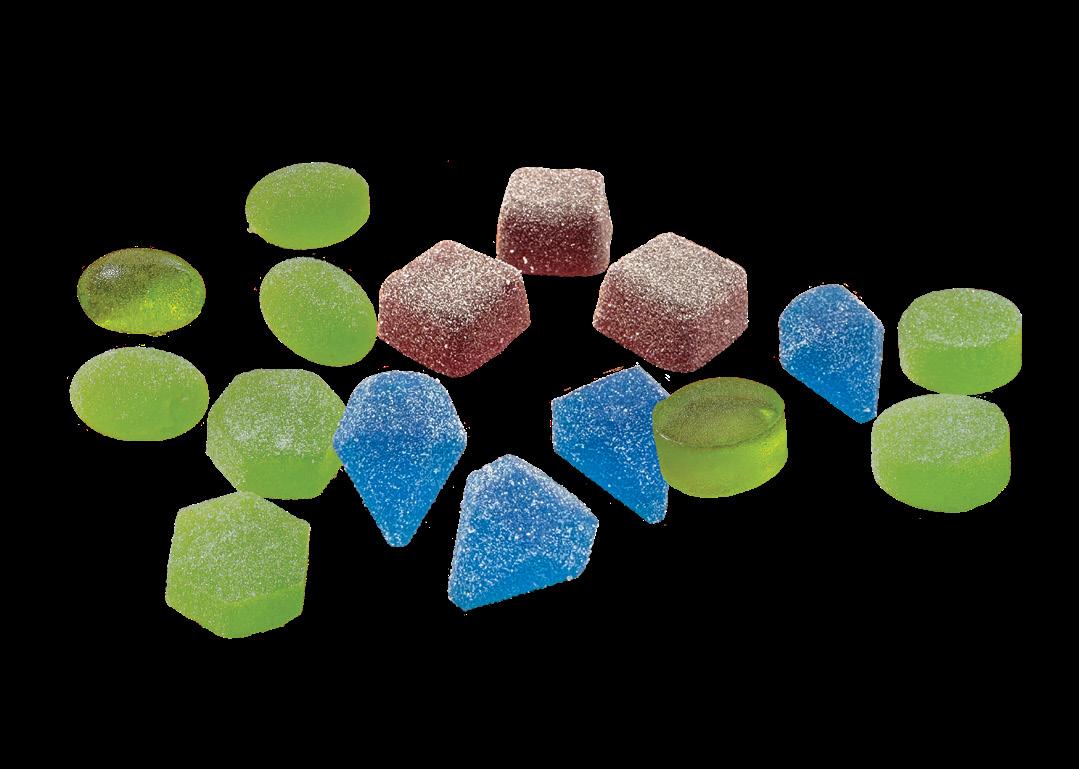








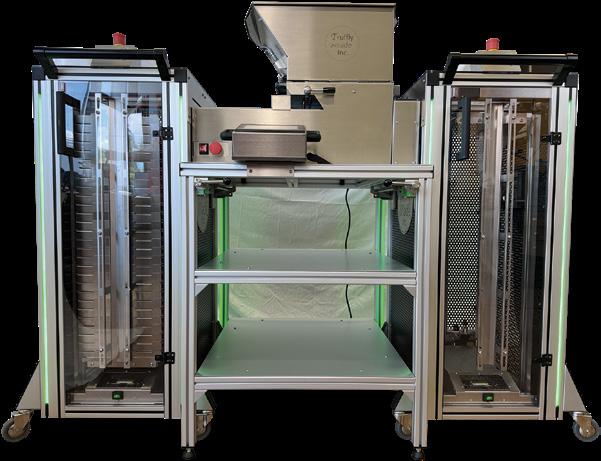

Founded in 2013, Truffly Made has quickly risen to prominence for its innovative approach to confectionery tools, specializing in high-quality silicone molds and the highly regarded Universal Depositors. The company’s products are trusted by professional confectioners, pastry chefs and chocolatiers worldwide, as well many of the largest manufacturers of Infused Edibles in United States and Canada.
Designed for both aspiring entrepreneurs launching their company and established manufacturers seeking to enhance their production capabilities, our panel of Universal Depositors and Demolders combines precision engineering with unparalleled reliability.
With a legacy rooted in craftsmanship and innovation, Truffly Made equipment line is not just a purchase; it’s an investment in your business’s future. Whether you’re starting out or scaling up, our equipment is your perfect partner in success. Embrace the excellence of German engineering and elevate your manufacturing process today!



















Take your cannabis packaging operations to the next level with industry leading technologies that will help you meet demand while ensuring high quality and low giveaway.


LOOKING BACK. PRESSING FORWARD. ALWAYS INNOVATING.
36
This 14-head weigher is capable of handling ultra-low target weights at high speeds with unsurpassed accuracy, weighing 0.5 to 50.0g portions at up to 120 weighments per minute. Flexible configurations are available for a two or four discharge pattern.






Aron Vaughan Managing Editor
A lot has happened in the world of cannabis since I left the scene almost two years ago.
Of course, I didn’t really leave the scene. Cannabis is a lifestyle, right? One can’t help but follow the legislative highs and lows, industry machinations, and accelerating tech advances in the space.
Just a few of the many highlights in the last 24 months include medical or recreational cannabis legalization in Mississippi, Rhode Island, Maryland, Missouri, Kentucky, Delaware, Minnesota, and Ohio. This momentum denotes a great leap forward in the evolving perception of the plant.
On a federal level, President Biden pardoned cannabis offenses, and we recently learned politicians from both sides of the aisle will fight to downgrade cannabis from a schedule I to schedule III drug. Of course, there is still much progress to be made.
On the tech and retail side, powders and potions have become more streamlined and widely available. Now, cannasseurs can sip on a THC-infused cocktail anywhere, anytime. What a time to be alive.
We’re covering some of those advancements and much more in our Retail Tech issue. As we head into the holidays, we want everyone to be up to date with
all of the stocking stuffers, collector’s boxes, and tech so you can find the perfect gift—not a “re-gift” gift.
Speaking of gift ideas, what more could a cannabis enthusiast ask for than an authentic RAW-branded skateboard, rolling tray, or papers? We’re featuring RAW founder Josh Kesselman in this issue to catch up on what’s happening in the world of pre-rolls, premium papers, and the cannabis community at large.
Heading back to one of the grassroots states, we checked in on some of the most innovative operators in Oregon to find out more about how they thrive in an increasingly competitive market.
For entrepreneurs and small businesses, this issue houses insights into every sector, including marketing strategy optimization, new and optimized cultivation techniques, and much more.
We at Cannabis & Tech Today hope there is something for everyone in this issue, providing insights for startups, gift ideas for the lovable stoners in your world, and deep dives into the latest in legislation, cultivation, and sustainability.
See you all on the other side of 2025. Until then, happy rolling!

What’s happened since the last issue of Cannabis & Tech Today?
“Life moves pretty fast. If you don’t stop and look around once in a while, you could miss it.”
– Ferris Bueller
This quote is no more true than in election years. Since our last issue debuted in September, there have been wins, losses, disappointments, and elations—largely depending on which state you live in.
Medical cannabis passed at the ballot box in Nebraska, but recreational measures were knocked back in the Dakotas and Florida. The failed amendment in the Sunshine State is no doubt a significant blow to Trulieve CEO Kim Rivers, who spoke of her advocacy efforts in the state in a candid interview last issue.

The election of Donald Trump to the presidency once again, other politics aside, means mixed results for the cannabis community. While Vice President Kamala Harris was explicit in her support for federal legalization, Trump has only gone so far as to voice his advocacy for rescheduling cannabis from Schedule I to Schedule III. Two steps forward, one step back, as it were.
On a less political note, our Women in Cannabis issue was a hit, highlighting the many women leaders in our growing community. While female CEOs, thought leaders, and culture ambassadors continue to propel the industry to new heights, Cannabis & Tech Today had the honor of putting just a few of their achievements in the media spotlight.
This publication is dedicated to the dreamers, the innovators, the collaborators, and the doers—who can’t be bothered by those saying it can’t be done. Nicholas and Aria, the future is yours!

For print or digital subscriptions, visit cannatechtoday.com, or find us on popular digital newsstands and readers.

PUBLISHER/EDITOR-IN-CHIEF Charles Warner cwarner@goipw.com
CREATIVE DIRECTOR Shane Brisson shane@goipw.com
MANAGING EDITOR Aron Vaughan
ASSOCIATE EDITOR Lindsey Feth
CONTRIBUTING WRITERS Alain Vo
Carlos Perea
Darwin Millard
Dr. Benjamin Caplan
Evan Nison
Ismael Lira
Jake Ritter
Jamie Lynn Dodd
Jim Sanfilippo
Kevin Brooks
Mary Jane Gibson
Niklas Kouparanis
Paul McKay
Ryan McMullen
Sara Brittany Somerset
Scott Lynch
CHIEF REVENUE OFFICER Jessica Ferranti
VP OF BUSINESS DEVELOPMENT Dave VanNiel
ACCOUNT EXECUTIVES Erika Masso
Andrew Behringer
Jimmy Chiminski
Catherine Richmond
MARKETING Deneka Scott
VIDEO/PODCAST PRODUCER Alan Tuszynski
DISTRIBUTION CMG
PRINTING Journal Graphics
Published by: INNOVATIVE PROPERTIES WORLDWIDE, INC 1750 Wewatta Street, #1821, Denver, CO 80202 | (720) 476-4920 www.cannatechtoday.com | info@cannatechtoday.com
To learn more about unique advertising opportunities, please contact us at 720-476-4920.
CANNABIS & TECH TODAY –Vol. 6/Issue 3 is published quarterly for $19.95 per year by Innovative Properties Worldwide, 1750 Wewatta Street, #1821, Denver, CO 80202
POSTMASTER: Send address changes to CANNABIS & TECH TODAY, 1750 Wewatta Street, #1821, Denver, CO 80202
and may not be individually





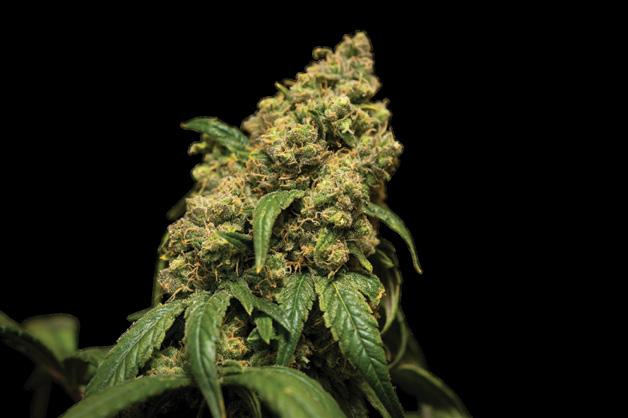
CARMA Product Overview
Program Designed Exclusively for Cannabis and Hemp Operations
AM Best Rated Reinsurance
37 States of Operation
Cannabis Stock Throughput Coverage
MSO Specific Pricing Model
Coverage for New Cannabis and Hemp Ventures
TIV up to $10M per Location (Allows for Schedule of Multiple Locations)
Direct Access to our Cannabis Underwriters
Fast and Seamless Quote, Bind, and Issue Process
Low Minimum Premium
Occurrence Coverage & Claims Made
We’re empowering growth and harvesting peace of mind with tailored coverage for the cannabis industry.
Cultivation, Including Indoor Crops
Manufacturing & Packaging Wholesale Dispensaries
Inland Marine & Cargo
Laboratory & Testing
Cannabis Specific Coverages
General Liability & Products
Commercial Property
Excess Liability
Worker’s Comp
Directors & Officers
Errors & Omissions
EPLI & Crime
Cyber Liability
Commercial Auto

100
Something
















Darwin Millard, colloquially known as “The Spock of Cannabis,” Millard is the Technical Director for Cannabis Safety & Quality (CSQ), the first accredited certification program to meet ISO requirements and regulatory requirements from seed-to-sale for the manufacture of cannabinoid-containing products.
Dr. Benjamin Caplan co-founded CED Clinic, CED Foundation, and EO Care, Inc., where he pioneers patient care and digital cannabis education. His latest book, “The Doctor-Approved Cannabis Handbook,” translates extensive clinical research into accessible guidance on effective cannabis therapies.
After being diagnosed as a Juvenile diabetic at the age of 14, Jamie Lynn Dodd’s life’s passion has been treating patients with medical marijuana, which she proudly does in her home state of Ohio advocating plant medicine and representing cannabis brands.
Ismael Lira has been incarcerated for over 20 years while serving a life sentence for a non-violent cannabis conviction in connection with the transportation and distribution of the plant.
Jim Sanfilippo, CEO of VIST Labs, is a leader with more than 30 years of experience in the packaging industry and is credited with developing more than 100 patents representing major advances in flexible and forming film packaging materials for fresh and processed foods, health care products, and other packaged goods.
Ryan McMullen is the Founder of Zohr Stohr Media, an agency that specializes in customer acquisition and maximizing customer lifetime value for dispensaries. After 20+ years in digital marketing for traditional brick and mortar businesses, Ryan decided that the added challenge of compliance was a good idea.
As the CEO of LeafyPack, an automation machinery supplier for the cannabis industry, Alain Vo has spearheaded advancements in packaging technologies over the past five years. His career in the cannabis sector also extends beyond LeafyPack, having previously contributed to the development of LED grow lights.
Kevin Brooks is Chief Executive Officer of Conception Nurseries. As the former CEO of both Cookies Management and Connected Cannabis, Kevin Brooks recognized early-on that plant health was the largest vulnerability in the cannabis supply chain.
Carlos Perea is CEO and Co-Founder of Terra Vera.
Scott Lynch is the founder of HashDash, the world’s first personalized cannabis matching platform that helps consumers find their ideal cannabis products through over 637,000 cultivar data points.
Niklas Kouparanis is the CEO and Co-Founder of Bloomwell Group, a Frankfurt, Germany-based medical cannabis company that has become a central hub for a new cannabis ecosystem that covers the entire value chain (except cultivation).
Evan Nison is a member of the NORML Board of Directors and sits on the Board of Directors of Students for Sensible Drug Policy. He is the founder of the PR firm NisonCo, which connects leaders in the legal cannabis, medical marijuana, and hemp industries with influential journalists across the U.S. and world.
Sara Brittany Somerset, Ph. D, a United Nations and cannabis correspondent, brings a global perspective to cannabis reporting, covering key issues and developments at the intersection of international policy and cannabis reform.
Mary Jane Gibson has been tracking cannabis legalization since 2007. The former culture editor at High Times, Mary Jane writes for a number of outlets covering cannabis culture, news, cutting-edge trends, and the communities that have given rise to the cannabis industry.
Jacob “Jake” Ritter is the Arizona Sales Director at Aeriz, a multi-state cannabis operator based in Chicago, Illinois known for being the largest cannabis aeroponic grow in the world.



By Paul McKay
In 2024, the cannabis industry experienced a wild ride, full of rapid growth, shifts in consumer behavior, and ever-evolving regulations. What once danced on the fringes is now stretching its limbs into the mainstream economy, bending laws and testing boundaries at every turn.
According to a report by MJBizDaily, the cannabis e-commerce market hurtled toward $10 billion in 2024, a number that has retailers sweating and investors seeing green. This surge is fueled largely by the Gen Z crowd, the restless digital natives who demand fast, flawless online shopping with delivery speed that would make a pizza guy blush. And it turns out same-day delivery boosts their loyalty by 35%, according to research by Flowhub.
The convenience champions? Pre-rolls and edibles. These smoking media reign as top sellers with online sales spiking up to 20% in the last year. Consumers have a nose for deals; nearly half won’t bite without a discount, driving stores to roll out aggressive loyalty programs and cutthroat pricing
In this scramble for dominance, brands are pumping cash into digital marketing, SEO, and social media influencers. Local SEO alone spikes engagement by 30%, while sites integrating influencers into their marketing campaigns see a 28% higher conversion rate. But, it’s a tightrope walk; with regulators watching, ID verification tech is no longer a suggestion—it’s essential
Photos: iStockphoto.com
35%
Boost given to e-commerce sites with “same day delivery” option.
Source: flowhub.com
45
Percentage of customers who seek discounts, pushing retailers into aggressive deals and loyalty programs.



20%
45% annually: The rate at which infused products are growing.
Source: fortunebusinessinsights.com
Increase in sales for pre-rolls and edibles online vs in-store
28%
Conversion rate increase for e-commerce platforms using Social media campaigns with influencers.
30% higher engagement: Retailers using local SEO engagement rather than traditional marketing alone.
Source: mjbizdaily.com

$6 billion:
Expected sales for CBD e-commerce brands by 2026. Source: statista.com

Held on Oct. 3–4 in Cleveland, Ohio, CannaCon Midwest brought cannabis industry professionals from across the Midwest to network and explore the latest developments in cultivation, processing, and retail. Known for its focus on innovation, CannaCon provided attendees with access to new technologies and business strategies, spotlighting the unique challenges and opportunities of the Midwest market. Educational panels and exhibitors offered a range of products and services, from cultivation equipment to compliance software.
Taking place on Oct. 4–5 in Cleveland, Ohio, Crain’s Cleveland Business Cannabis Summit focused on the business side of the cannabis industry. Topics included investment opportunities, financial trends, and the regulatory challenges facing businesses in the Midwest. The summit attracted a mix of investors, financial analysts, and business owners who discussed the nuances of raising capital and navigating Ohio’s regulatory environment.
On Oct. 18–19, Newark, New Jersey, hosted the Real Cannabis Entrepreneur Conference, a gathering focused on helping cannabis entrepreneurs develop successful businesses. With a mix of expert panels and networking sessions, the conference offered actionable insights on topics ranging from securing funding to building a brand. Key speakers shared experiences on navigating regulatory hurdles, operational challenges, and the importance of cultivating a positive company culture. Attendees left equipped with practical advice and tools to apply directly to their ventures, making the event a valuable resource for both new and established entrepreneurs.
On Oct. 4, Hartford, Connecticut, hosted NECANN’s Connecticut Cannabis & Hemp Convention, a one-day event designed to support the state’s rapidly growing cannabis and hemp industries. This convention featured local dispensaries, cultivators, and ancillary businesses. Attendees could participate in educational panels that addressed the latest regulatory changes, product innovations, and best practices.
The World CBD Awards, held in Lisbon, Portugal, from Oct. 8–10, celebrated excellence within the CBD sector. This prestigious international event recognized brands that uphold rigorous standards in quality, safety, and transparency. Companies from around the globe presented their products, from tinctures and topicals to edibles and wellness products, competing for awards in categories like product innovation and ethical production.
Held on Oct. 25 in Syracuse, New York, NECANN Syracuse showcased the emerging cannabis market in New York State. As the state’s legal cannabis industry continues to take shape, this event provided a platform for industry stakeholders to discuss regulations, licensing opportunities, and community impact. The event emphasized the importance of local businesses in shaping a socially responsible market.
MJ Unpacked arrived in St. Louis with a dynamic event held at the Four Diamond Union Station Hotel. The conference featured an interactive expo hall, a Beatles-themed light show, expert panels, and XL gift boxes from local dispensary Blue Sage Cannabis Deli. Attendees also enjoyed a “puppy playpen” sponsored by Headset as part of an adopt-don’t-shop initiative. This creative addition, along with on-site massages from PayPro, provided stress relief and a sense of community.
On Nov. 12, New York City hosted the Business of Cannabis conference, where industry leaders, investors, and policymakers gathered to discuss cannabis legalization and its implications for businesses. Key topics included regulatory updates, market opportunities, and investment trends, with a focus on positioning New York as a major player in the cannabis industry.

Find the right CBD treat for your four-legged critic.
By Sara Brittany Somerset


The holidays can be a stressful time for pooches and people, with in-laws underfoot, all sorts of cooking smells, and perhaps even travel or being temporarily away from their owners. Below is a guide to keeping pups calm during the holiday whirlwind. All of the products below were safely and humanely tested by Cannabis & Tech Today’s working K9 @AximGSD.
Bad Apple Pets’ Doggie Dreams Serenity Treats ($19 for 16oz) contain 5mg of pure spectrum CBD per all-natural, gluten-and-dairy-free treat. Bad Apple Pets is a family-owned business founded with furry friends in mind. They handcraft every treat in small batches with clean, human-grade ingredients, including rolled oats, natural peanut butter, and pumpkin, while the full-spectrum CBD oil comes from hemp plants grown on their local farm in Wisconsin.
Calm Bundle ($94.98) — This bundle is designed to calm pets during stressful times. Pet owners will have peace of mind when furry pals are at home without their human, courtesy of calming hemp drops with lavender essential oil. Blanche’s Edibles help pups relax while supporting joint health and mobility.
Blanche’s Edibles ($19.99) are nutritious treats that provide a sense of calm during situational stress, such as fireworks, thunder, or separation anxiety. With a consistent and reliable hemp dosage in every bite, Blanche’s is ideal for calming pets during hurricane season.
Nourish Hemp Salve ($39.99) — As the ground gets colder, paws can become callous and cracked. Nourish Hemp Salve moisturizes paws, noses, and elbows while protecting against dehydration.
Ease Hemp Oil Tincture ($87.99) — The company claims this tincture will get a pet moving by relieving their aches and pains. It also supports joint health with turmeric.
Wisdom Panel Premium is the ultimate dog DNA test for the obsessed pet parent. It screens for 365+ breeds and tests for over 265 genetic health conditions. The test also screens for 15 behavioral predispositions, over 50 physical traits, and allows users to discuss any “at risk” health discoveries with a veterinary genetics specialist. Pets are members of the family, so it makes sense to want to be as informed as possible of their specific characteristics. As an added bonus, with a database of 4.5 million pets, it’s easy and fun to locate Fido’s long-lost littermates, like using Ancestry.com for dogs. ❖



Rewrite the rules of hemp retail with seamless transactions, real-time compliance, and data insights.
By Paul McKay
The future of hemp retail is nothing short of a digital revolution—a wild leap forward where “smart” POS systems are moving faster than the law can keep up. The smoky underworld of manual spreadsheets and cash registers is giving way to sleek, automated systems that track every transaction down to the dime and leaf. POS technology is a must-have weapon for hemp retailers, one that blends compliance and customer service with a hint of Big Brother surveillance for good measure. Navigating Compliance and Customer Service
These POS systems are precision-engineered to handle the head-scratching regulations that hemp retailers are all too familiar with. Enterprise Resource Planning (ERP) systems that link straight into state regulatory databases offer a compliance cushion that keeps businesses one step ahead of the regulatory axe, saving hours of paperwork and reducing the risk of a pricey infraction.
Then there’s the customer
experience—a matter of survival in the modern hemp world, where a clunky, slow checkout experience can quickly blow your chances at a repeat customer. Today’s POS systems meet the demand for smooth, cashless transactions like ACH and mobile payments, helping retailers sidestep the cash-only stigma that haunts the cannabis sector.
Customers breeze through, business gets a shot in the arm, and those who know how to wield these tech tools rake in the rewards.

One more ace up the sleeve for hemp retailers embracing POS systems? Data-driven strategy. Beyond tracking sales, smart POS setups give retailers the ability to read their customers like a novel. With built-in analytics, these systems slice and dice data to show exactly what products move, what sits, and who’s buying what. It’s a treasure trove for any hemp retailer looking to refine inventory, boost upsells, and home in on peak sales times.
In essence, these POS systems keep money in your pocket. Employee access tracking, inventory monitoring, and cash drawer-specific transaction logs make it harder for sticky fingers to pilfer from the profits. With automated reporting and deep analytics, smart POS systems help retailers get a razor-sharp picture of every nug and nickel, slicing shrinkage with surgical precision. It’s like having a watchdog and a data analyst rolled into one
With there being so many POS systems available it can be difficult
to weed through the options but Proteus 420, for example, is more than just a POS system—it’s a full-on command center designed for the wild terrain of cannabis compliance. This system handles everything from inventory to customer relationships, sales tracking, and, most importantly, compliance with state databases like METRC.
Hemp retailers have one choice: adapt or be left in the dust. The right POS system is a survival kit, providing the real-time reporting, transaction security, and cashless convenience that keeps customers happy and regulators at bay. ❖




Discover which potent blend suits your needs for a tailored high.
By Paul McKay
An infused pre-roll is a cannabis joint that has been enhanced with additional concentrates or extracts to boost its potency, flavor, or effects. These pre-rolls combine regular flower with cannabis concentrates, giving them considerably more “kick” than a standard pre-roll.
Some of the most popular infusions include:
Kief-infused pre-rolls: These are rolled with cannabis flower and coated in kief, which is a collection of trichomes containing concentrated cannabinoids and terpenes.
Hash-infused pre-rolls: Hash, made from compressed trichomes, is mixed into the flower to enhance potency.
Oil-infused pre-rolls: Cannabis oils or distillates are added to the joint, providing a more potent hit.
Live resin-infused pre-rolls: Made with live resin concentrate, which is extracted from fresh, flash-frozen plants, enhancing the terpene profile for richer flavors and effects.
Each infused pre-roll offers a unique combination of enhanced potency, flavor, and effect, providing tailored experiences based on individual preferences, but how do you know which one is the best option for you? To start, you’ll have to know what to expect from each type of infused pre-roll.
The infused pre-roll experience
Kief-infused pre-rolls: Kief boosts the overall THC content, resulting in a more potent high. Users often experience heightened euphoria, deep relaxation, and an amplified sense of wellbeing. The effects are faster-hitting and longer-lasting compared to regular pre-rolls.
Hash-infused pre-rolls: Hash tends to provide a



A) Available in multiple sizes, Jetters also feature strains like Blue ZKZ, Orange Daiquiri, and Granddaddy Purp. B) Golfinger’s produce a uniquely flavorful, high potency experience with a wide variety of flavors such as Blueberry, Strawberry, Pineapple, and Tangerine. C) STIIIZY offers a rotating selection of both Indica, Sativa, and Hybrid strains to suit different preferences and effects.
smooth, balanced high. Users often feel a calming body buzz paired with cerebral relaxation. The effects are typically mellow but more intense than flower alone, making hash-infused pre-rolls ideal for those looking to relax without feeling overly sedated.
Oil-infused pre-rolls: Cannabis oil or distillates deliver a concentrated dose of cannabinoids, resulting in a stronger, more immediate high. Users often experience a powerful sense of euphoria and can feel either energetic or deeply relaxed depending on the strain. The effects tend to hit fast and last longer.
Live resin-infused pre-rolls: Live resin is rich in terpenes, leading to a more flavorful and aromatic experience. Users report a more vivid, sensory high that enhances both mental clarity and mood. The effects can be uplifting and euphoric, while also offering relaxation and relief from stress or anxiety, thanks to the terpene-rich profile.
Jeeter’s infused pre-rolls have made a huge name for themselves in the cannabis market with their high-potency products and luxurious touches. Known for their signature kief-coated joints, Jeeter offers a wide variety of infused prerolls. Consumers highlight the smooth, flavorful smoke and immediate effects that last around 40 minutes.
Their main offerings include:
Jeeters and Baby Jeeters pre-rolls are infused with liquid diamonds and dusted with kief, making them one of the most potent options on the market. Baby Jeeters are smaller but pack just as much punch, boasting around 35-45% THC content.
Cannons and Baby Cannons pre-rolls are infused with premium live resin and offer a similarly elevated experience. They’re designed for both seasoned users and those seeking a premium, indoor-grown flower.
House of Cultivar’s “Goldfinger”
These tasty pre-rolls are handcrafted flower joints coated in a terpene-infused distillate that is then diamond-dusted with refined dry sift to create a harmonious blend of potency and flavor. For perspective flavors such as “Strawberry Goldfinger” are 41.8% THC, and 0.3% CBD with other various flavors reaching near the same levels. .
Stiiizy 40’s
Named for their impressive strength, STIIIZY 40’s consistently deliver a rich cannabinoid profile. Expect a smooth, flavorful, and slowburning experience with every puff. Each .5-gram pre-roll starts with premium cannabis flower, infused with live resin, and rolled in a kief-coated cone for maximum potency. ❖

Your customers, your flower, and your bottom-line deserve better. Experience the best in pre-roll automation with the RollPros Blackbird. Use fresh, high-moisture flower and a coarse grind. Dial in the perfect airflow at the touch of a button. Produce the highest-quality joints on the market at 1/4 the cost.

Upgrade your production with the RollPros Blackbird. View an on-demand demo or request a live one by scanning the QR code.
Skipping cannabis conferences could be your biggest business blunder of 2025.
By Evan Nison
I’ve witnessed firsthand how the cannabis industry is built on community and innovation, and nowhere is this more evident than at cannabis conferences and events. The industry’s lineup of conventions to cater to every niche grows yearly, as do the attendee lists of existing conferences.
In 2023, MJBizCon, one of the most wellknown cannabis events in the United States, brought over 35,000 attendees together. The potential for business development and technological growth through cannabis conferences is unmeasurable.
As the founder of the country’s oldest cannabis PR firm, NisonCo, I want to share two of the most significant ways that cannabis conferences have helped my company and clients’ companies grow and transform. With potential cannabis rescheduling on the horizon and cannabis legislation on the ballot in virtually every recent election, there’s no better time to get involved with the larger industry by attending conferences.
Cannabis Conferences Provide Opportunities for Business Development
Most foundationally, cannabis conferences are incredible opportunities for business development. As the industry grows and more cannabis companies enter the scene, building a solid network of professional connections is more important than ever, especially for small- to medium-sized businesses.






In-person events like cannabis conferences are especially important in a product-centered industry like cannabis. We discuss and build connections at conferences centered around the products, services, and experiences our industry is built upon. The sector has seen incredible innovation over the past years, with formerly niche products like beverages taking off and new technology hitting the scene, and in-person events are undeniably the best environments to showcase these advancements.
Over the years, I’ve discovered that while online networking on websites like LinkedIn can be great for connecting with new contacts and checking in with established contacts, inperson connections are essential in building stable and mutually beneficial long-term partnerships. At cannabis conferences, you can feel confident that all other attendees are also there to network and connect with the industry. In an open, collaborative atmosphere like this, it’s easy to make introductions and build rapport with new and old contacts alike.
I’ve observed that conference attendees consistently bring their A-game, eager to share
innovative ideas and learn from their peers. Brands can present these exciting products and services and, most importantly, receive immediate feedback to help them reach new heights.
Both business-to-business (B2B) and business-to-consumer (B2C) events can help drive innovation and industry in the cannabis sector. MJBizCon and CannaCon are two of the most well-known B2B cannabis conferences, but dozens of other events cover varied niches.
At B2B conferences, cannabis professionals can share ideas, brainstorm new approaches to shared problems, and develop innovative ideas, all while receiving direct input from other industry professionals.
B2C cannabis conferences aren’t limited to simple sales events. More than ever, consumers are interested in the culture, technology, and science behind the cannabis plant, and B2C conferences are an incredible way to cater to curious customers. Events that combine education, entertainment, and often a healthy dose of competition, like The Emerald Cup and the Alternative Products Expo, allow industry players to connect directly with consumers who are passionate about the industry. They’re great
places to debut new products and services, gauge customer reactions, and get immediate feedback in an exciting environment.
Make the Most of Upcoming Cannabis Conferences
If you’ve ever attended a cannabis conference, you know that they are fun, rewarding, and often overwhelming. I follow a few best practices to ensure that our team achieves all of our goals at each conference or event we attend.
First, prepare for the conference ahead of time. Make a list of all the people, booths, and vendors you want to visit and prepare for your interaction with each contact. I like to divide that list among relevant teammates to disperse the workload. Next, familiarize your team with a map and event schedule to make your time at the conference as streamlined and efficient as possible.
Throughout the long event, remember the basics when you attend cannabis conferences: You must have comfortable shoes, extra water, and nutritious snacks to keep you fueled and ready to network.
Finally, if providing interviews and building your company’s press portfolio are goals, invest in cannabis media marketing guidance from a cannabis PR firm to ensure your conference experience goes smoothly. A cannabis public relations agency will help you decide which conferences are most relevant to your business and land you coverage and connections before, during, and after the conference.
I’m confident that the cannabis industry’s continued growth will create even more opportunities for businesses to thrive. Attending conferences is essential to staying ahead of the curve, and I strongly recommend attending at least two industry conferences per year to maximize your networking opportunities.
Cannabis conferences are one of the best ways to grow your company and contribute to the sector’s growth as a whole. To participate in the conversation, ensure your company attends cannabis events—with a solid plan of action in place—in 2025. Maybe I’ll see you there. ❖





Germany’s cannabis market is exploding post-legalization, but education—not supply—may be its biggest hurdle.
By Niklas Kouparanis
When Germany implemented one of the world’s most progressive pieces of cannabis legislation, the Cannabis Act (CanG), on April 1, 2024, a significant question emerged: will the country’s medical market be able to meet the expected spike in demand that will likely result from CanG’s reclassification of the plant as a non-narcotic?
With bureaucratic hurdles removed and physicians empowered to prescribe cannabis like they would other Rx prescriptions for a broader range of common conditions, many were concerned that Germany was not prepared to accommodate an influx of new patients.
Fortunately, thanks to imports, the concerns can be put to rest— for now. Germany imports cannabis from around 15 countries, the majority being from Canada. According to the latest data from BfArM (Federal Institute for Drugs and Medical Devices, the country’s medical regulatory body), Germany imported 11.7 tons of dried cannabis flower into the country for “medical or scientific purposes” in the second quarter of 2024. This marks a 44% increase
from the first quarter of the year and a new record high amount of import in any single quarter since medical cannabis was legalized in 2017.
This increased supply is reaching patients who are in need; according to data from Bloomwell Group released in July 2024, the number of prescriptions our platform dispensed increased 400% from March 2024 to June 2024.
As our market continues to grow, we’ll need to continue to ramp up the amount of cannabis we import, as we’re projecting that Germany will be the number one medical cannabis market in the world. With reclassification in place, the number of medical cannabis patients in Germany is expected to climb from our previous tally of around 300,000 to a few million patients within two years.
However, for Germany’s medical market to reach its full potential, we need to address the ongoing issues of lack of awareness and education, and the stigmatization of cannabis. According to a representative survey conducted by Bloomwell in August 2024 on why Germans use cannabis, 94%

Ausgegeben zu Bonn am 27. März 2024 Nr.
Gesetz
zum kontrollierten Umgang mit Cannabis und zur Änderung weiterer Vorschriften (Cannabisgesetz – CanG)
Vom 27. März 2024
Der Bundestag hat das folgende Gesetz beschlossen:
Inhaltsübersicht
Artikel 1 Gesetz zum Umgang mit Konsumcannabis (Konsumcannabisgesetz – KCanG)
Artikel 2 Gesetz zur Versorgung mit Cannabis zu medizinischen und medizinisch-wissenschaftlichen Zwecken (Medizinal-Cannabisgesetz – MedCanG)
Artikel 3 Änderung des Betäubungsmittelgesetzes
Artikel 4 Änderung der Betäubungsmittel-Verschreibungsverordnung
Artikel 5 Änderung der Betäubungsmittel-Außenhandelsverordnung
Artikel 6 Änderung der Besonderen Gebührenverordnung BMG
Artikel 7 Änderung des Arzneimittelgesetzes
Artikel 8 Änderung des Bundesnichtraucherschutzgesetzes
Artikel 9 Änderung des Jugendarbeitsschutzgesetzes
Artikel 10 Änderung der Arbeitsstättenverordnung
Artikel 11 Änderung des Bundeszentralregistergesetzes
Artikel 12 Änderung des Strafgesetzbuchs
Artikel 13 Änderung des Einführungsgesetzes zum Strafgesetzbuch
Artikel 13a Änderung der Strafprozessordnung
Artikel 14 Änderung der Fahrerlaubnis-Verordnung
Artikel 14a Änderung des Gerichtsverfassungsgesetzes
Artikel 14b Einschränkung von Grundrechten
Artikel 15 Inkrafttreten
of respondents reported they consume cannabis for at least one medical or health reason. The most common conditions reported were sleeping disorders and stress relief, followed by pain relief.
However, 90% of the survey participants acquired cannabis from the illicit market, rather than exclusively from a licensed pharmacy, within the past year. A large portion (79.6%) said they’d had negative experiences with purchasing cannabis from the


unlicensed market, or feared side effects or potential health risks from illicit products.
There is clearly a strong and growing demand for cannabis to treat common health ailments. But public health outreach is needed so potential patients know that they can now access safe and verified medical cannabis as they would any other Rx prescription. They no longer need to turn to the illicit market and should not be pushed in that direction.
But it’s not just patients who need to be made aware—it’s the medical community. For too many physicians in Germany, medical cannabis is still a taboo subject. But from a legal perspective, medical cannabis is now equivalent to other prescription medications such as pain relievers, sleep aids, and antidepressants.
The plant has proven potential to help provide relief to patients with a range of conditions, including common issues like stress and sleep disorders; both are widespread conditions in Germany that are often overlooked for medical treatment or treated insufficiently.
Our data shows that, even though a third of the consumers surveyed have already been diagnosed with a qualifying medical condition by a doctor, more than 21% who consulted with a doctor did not have medical cannabis prescribed to them. About 25% of respondents said that doctors were unable to help with their health problems. Only 9.2% stated that they were able to find a doctor who was able to help them with medical cannabis treatment.
The reclassification of cannabis as a non-narcotic was an important step toward normalization and destigmatization in Germany. However, we still need more resources allocated towards research studies on medical cannabis’ potential benefits and effectiveness. Public health officials also need to reach out to physicians with educational guidance on how best to prescribe medical cannabis and help patients navigate their respective treatment journeys. Even private companies in the industry need to continue to support research studies to add to the growing body of evidence for medical cannabis.
By prioritizing consumers with health-related motives and physician awareness, the number of medical cannabis patients in Germany actually has the
potential to surpass the previously cited projection of “a few million patients within a few years.” According to the aforementioned Bloomwell online survey on cannabis consumption in Germany with 1,009 people who have consumed cannabis at least once in the last 12 months or have taken it medicinally as a patient, extrapolated more than 20 million people could benefit from medical cannabis.
With the demand firmly in place and early successes on record, the future of medical cannabis in Germany looks extremely promising. I urge our policymakers and public health officials to continue to take any and all steps needed to ensure the steady supply we need, along with education for physicians and patients alike. ❖


Mary Jane Gibson
After 20 years shaping cannabis policy, Shaleen Title shares insights on legalization, equity, and her next chapter.
Shaleen Title has a long view of legal cannabis. The founder and director of the drug policy think tank Parabola Center, Title is an attorney who has been writing, passing, and implementing equitable cannabis laws for over 20 years, while testifying before legislative bodies around the world about restorative justice. She also co-founded THC Staffing, the first-ever recruiting firm to focus on inclusion in the cannabis industry, and was a founding member of the Cannabis Regulators of Color Coalition. Boston Magazine’s Power List dubbed Title “the people’s weed watchdog” — an apt handle for the tenacious, brilliant activist.
Now, after two decades as a leading voice in the legal cannabis movement, Title is stepping back from drug policy work. We caught up with her to ask what’s next for her, and what she thinks legalization could look like in a new era of politics.
When did your commitment to drug policy work begin? What about it appealed to you?
I got involved through NORML and Students for Sensible Drug Policy when I was in law school. Early on, I wanted freedom for me and my friends to use cannabis; then it became more about social justice and curbing corporate greed. Everyone’s looking for belonging and connection, to feel like you can use your skills to help people. Drug policy work provided me with that.
Can you give us an overview of how you see federal legalization unfolding?
Well, I think federal legalization is inevitable because, for the first time, we had both presidential candidates endorse it. And of course, President Trump endorsed Amendment 3 in Florida. I think it’s only a matter of time — but we have no idea who will control it, and who will benefit from it. It will be a matter of which communities are the most persuasive, when the time comes. I’m using the term communities broadly; it could be corporations and lobbyists. But in the past, patients and consumers have been more


persuasive when it comes to drug policy reform than corporations have been. I don’t think it’s as straightforward as ‘whoever has the most money is going to have the loudest voice.’
Do you have a sense of how things might look under the second Trump administration?
I don’t think we’re necessarily going to see a lot of reform around marijuana under the Trump administration. In the short term, I’m concerned about whether we might see a crackdown. I think the smartest thing — the one thing that the entire industry and movement could probably unite on — is to strongly oppose criminal enforcement for anyone involved with marijuana.
How do you foresee things playing out between federal and statelevel legalization?
All we’ve ever seen is legal marijuana without interstate commerce; I think we don’t realize how much protection that has provided for small, craft, and social-equity businesses. If Congress descheduled marijuana altogether, we would immediately
“I think federal legalization is inevitable because, for the first time, we had both presidential candidates endorse it. And of course, President Trump endorsed Amendment 3 in Florida. I think it’s only a matter of time — but we have no idea who will control it, and who will benefit from it.”
see interstate commerce, which would result in a race to the bottom. The largest companies would flock to states with the least worker protections and the least restrictive consumer protections, manufacture there, and then export to other states. It will be critical for the states to be able to choose to protect small businesses by providing some kind of gradual transition for a defined period. Congress could make that happen, as long as they do it explicitly.
There are several pieces of legislation in play at the federal level. Do you see them coming together in a coherent way, or do we need to clean the slate and write something new?
My guess is that what ultimately passes will include different pieces of the bills that have been introduced. The most comprehensive is the Cannabis Administration and Opportunity Act (CAOA). Unless something else gets introduced, that will probably be the skeleton that other pieces get added to. You feel like the bones of the CAOA are the best option?
Yes — but I struggle to call it the best option, because it doesn’t address interstate commerce in any way. In my opinion, it also doesn’t prevent excessive corporate consolidation in any meaningful way.
Does it do any good for policymakers to address social equity concerns at the federal level?
Yes, absolutely. The Parabola Center did some research on the beliefs Americans hold around legalization. I wanted to ask about social equity, because I thought it might be associated with ‘wokeness.’ I expected that maybe 50 percent of people would support it. Surprisingly, 68 percent of people said they support legalization and ending arrests, which aligns with national polls — and in our study, 68 percent of people also said they support social equity when defined as trying to repair some of the harms caused by the war on drugs.
That result is very telling. People were very clear: legalization should benefit workers, patients, and consumers, not large
corporations, pharma, tobacco, or alcohol. If we want to maintain the popularity of legalization, and align it with what people want, it has to include social equity.
You’re stepping back from your work in drug policy. What’s next for you?
Myself, Shanel Lindsay, and Laury Lucien run Parabola Center. We’re all women of color who had a role in the implementation of cannabis legalization in Massachusetts. We’re lawyers, and have all been cannabis entrepreneurs. We felt well-suited to talk about the future of legalization, and we saw a strong need for federal policy rooted in racial justice and preventing corporate monopolies. I feel very proud of the expertise we’ve brought together, and the unique projects we’ve undertaken.
But as of the end of this year, I’m not going to engage in drug policy advocacy anymore. I want to pass the torch to fresh voices and perspectives. Legalization is something new now; it can’t be what we were doing 12 years ago. There’s an urgent need for a new, more effective message, because the old approaches aren’t working.
I want to work directly with students; I’m more interested in guiding the next generation of leaders than being a leader myself. And, if we want to keep up our sense of helping others, there’s a lot we can do. What has always worked is bringing people together, and fostering a sense of connection and belonging. The best way to achieve that is to get off our phones—something I’m working on myself—and connect with each other in our communities. ❖
AI and big data are finally solving the ‘bad high’ problem for cannabis consumers.
By Scott Lynch
As the cannabis industry continues to expand, the need to provide more consistent and positive consumer experiences is becoming increasingly important. A recent YouGov survey revealed that 54% of consumers reported unsatisfactory past experiences with cannabis, presenting an opportunity for the industry to enhance its approach. The challenge lies in the complexity of cannabis— thousands of strains with varying effects and benefits can make it difficult for consumers to navigate the market effectively. Without proper guidance, more negative experiences by the canna-curious may deter future use and foster incorrect assumptions about the industry as a whole.
Cannabis is far from a one-size-fits-all product, and its effects vary widely due to factors like body chemistry, tolerance, and the consumption method. Our bodies interact with cannabis through the endocannabinoid system (ECS), which regulates mood, pain, and appetite. This means each person’s ECS is unique, making cannabinoids like THC and CBD bind differently to receptors in the brain and body. In turn, this produces a wide range of effects. Further complexity arises from external factors, such as metabolism, age, and even prior cannabis use, all of which significantly shape a consumer’s experience. Because cannabis impacts consumers so individually, personalized guidance becomes critical.
Adding another layer of complexity, the effects of cannabis strains are not static—they can vary depending on how the plants are
grown and processed. Factors such as soil quality, climate, and light exposure impact the chemical composition of the plant. As a result, the same strain can have different levels of THC, CBD, and terpenes depending on its growing environment. Terpenes, which give cannabis its aroma, also influence its effects. Some, like limonene, promote energy, while others, such as myrcene, are known for their sedative effects. Additionally, the timing of the harvest and post-harvest processing can affect the potency and quality of the strain. Consumers often assume that a strain will provide consistent results, but this variability can lead to confusion and dissatisfaction if they aren’t aware of these nuances.
Despite the nuances of cannabis, many consumers still rely on limited or anecdotal information when selecting strains. Friends’ recommendations or product descriptions often lack the necessary detail, leading to mismatched expectations. This highlights the importance of more precise, data-driven approaches. Consumers need tools that can account for individual differences, product variability, and the context in which the strain was grown, all to deliver a more personalized and consistent experience.
Personalization has already revolutionized industries such as music and entertainment. Platforms like Spotify, with over 100 million songs, and Netflix, offering more than 36,000 hours of content, use advanced algorithms to provide consumers with tailored recommendations based on their preferences.

These systems help consumers navigate vast libraries of content by reducing choice overload and offering highly relevant suggestions. By analyzing consumer behavior and patterns, these platforms continuously refine recommendations, improving engagement and satisfaction. The same principle can be applied to cannabis, where the overwhelming number of strains and products would benefit from the same kind of data-driven personalization.
In the diverse cannabis industry, tech-driven solutions are essential for delivering the level of personalization consumers will increasingly expect. By analyzing broad sets of consumer data—such as consumer history, product feedback, and preferences—algorithms can identify patterns that would be difficult for any single consumer to discern. Much like how


Netflix or Spotify provide tailored content, technology can help match consumers with the right strains or products, taking into account individual factors like desired effects, conditions, and preferred flavor profiles.
At HashDash, we’ve worked hard to build a system that leverages the power of data to deliver personalized cannabis experiences. Through our platform, we use over 128 unique data points per cultivar and up to 121 consumer data points per user to create precise matches
between consumer preferences and product profiles. This detailed approach allows us to account for the variability in cannabis strains, ensuring that consumers receive recommendations based on their unique needs. We factor in everything from terpene profiles to cannabinoids, helping to reduce guesswork and improve the likelihood of a positive consumer experience.
As consumers interact with the platform, they
also contribute valuable feedback that refines our algorithm further. Each interaction helps our system learn and adapt, similar to how fitness apps adjust diet or workout recommendations based on user activity. Whether a user rates a strain positively or negatively, adjusts their preferences over time, or favorites a strain, our algorithm takes note and reacts. This dynamic process enables us to continuously improve the accuracy of our recommendations. Additionally, by collecting this data, we are also able to aggregate insights that help users with similar needs, creating a broader community of shared experiences.
Technology alone cannot solve the entire equation. While algorithms provide precision, human insights add context. Through user reviews and shared experiences, consumers gain a better understanding of how certain strains work for others with similar preferences. By blending data-driven personalization with community-driven insight, we create a more comprehensive cannabis discovery experience, offering both technical accuracy and practical advice from real users.
As cannabis moves further into the mainstream, the demand for personalized, datadriven experiences will only grow. Consumers will increasingly expect technology to help them navigate the complexities of cannabis, much like they rely on it for personalized recommendations in other industries. The shift away from anecdotal recommendations and toward databacked guidance will not only improve consumer satisfaction but also help legitimize the industry by providing more consistent, reliable experiences for consumers at all stages—whether they are new to cannabis or seasoned enthusiasts.
The future of cannabis lies in the combination of tech innovation and consumer insight. By using data to personalize recommendations and continuously improve based on feedback, companies like HashDash are setting the stage for a new era of cannabis consumption—one that is tailored, informed, and ultimately more enjoyable for every type of consumer. ❖

By Darwin Millard, ‘The
Director, CSQ
ASTM’s D37 Vape Device Safety and Testing Initiative aims to ensure they are.
Vaping has often been heralded as a “safer” way to consume either nicotine or cannabinoids than smoking, but how a consumer chooses to vape can have significant impacts on their health.
The vaping industry, particularly for cannabinoid products, lacks comprehensive safety and quality standards. This gap poses risks to consumers due to inconsistent device components and the potential presence of harmful materials. The vape devices themselves present a suite of risks, such as exposure to unwanted metals like copper, nickel, and lead.
Evidence from a Health Canada study published in early 2024 strongly suggests metal contamination can come from the device before it has even been used and may increase with use depending on the “quality” of the materials used in the construction of the device.
The ASTM D37 Vape Device Safety & Testing Initiative is a volunteer-driven collaborative effort that launched in January 2024 to develop standards that ensure cannabinoid vape devices are reliable and fit for purpose.
ASTM International is a globally recognized organization that develops and publishes accredited technical standards for a wide range of industries, materials, products, systems, and services. Committee D37 focuses on the development of standards for cannabis and its derived products. It has grown to include over 600 members from more than 30 countries and has published nearly 60 standards so far. The Initiative has identified 35 proposed standards to address the most pressing safety and quality issues related to cannabinoid vape devices.
Topography and Performance (Test methods to improve analysis and char acterization of aerosolized vapors and device performance metrics.)
Aerosolized Vapors and Emissions (Test methods to better understand cannabinoid delivery and degradation over time and assess risk from aerosolized contaminants.)
Device/Hardware Design (Specifications for components and hardware that will result in better performing, higher quality, more fit-forpurpose vape devices.)
Components and Interactions Therewith (Test methods for characterizing materials used and interactions with cannabinoid substances to reduce harm and increase the quality of materials.)
Consumer Usage Characteristics (Puffprofiles and other topographies to better model real-world consumer usage habits to improve performance and harm reduction testing.)
As these standards are completed, Cannabis Safety & Quality (CSQ) will utilize them to create a much-needed, accredited Vape Device Performance and Harm Reduction Certification Program.
In order to move forward, however, the ASTM D37 Vape Device Safety & Testing Initiative needs more data and research to better inform the standards development process. In terms of what type of research is needed to properly draft these standards, we primarily need to understand WHAT we are inhaling and HOW we are inhaling to ensure these devices are safe for consumers to use regularly.
We all know the ceramic used to make nearly all cannabinoid vape device atomizer cores is a brittle material that can crack and flake. This is especially true when it’s repeatedly heating up and cooling down inside of your vape device. These flakes, or rather jagged shards of ceramic, are nanoparticle-sized and can be mobilized when someone inhales through the device. The possibility that vape devices themselves may be leading to silica dust exposure is alarming, both for the average and chronic consumer, who could be literally killing themselves without knowing it.
Silica dust and nanoparticles are known health hazards, which is why the long-term health effects of ceramic-based atomizer technologies should be investigated.
Additionally, materials used to create conductive wiring materials for the device could also bring about potential health concerns. When it comes to testing for elemental impurities, most regulatory markets only address the big four—arsenic, cadmium, mercury, and lead, none of which are found in these materials.
Nichrome and stainless steel are the most common materials used in this case, which contain nickel, chromium, and molybdenum, in the case of stainless steel. These elements have defined concentration limits for products to ensure safety, but since vape products are not being tested for these elemental impurities, are we overlooking a potential health concern? Just like with the ceramic core, are we unknowingly inhaling hazardous materials, like toxic gases, every time we use a vape device?
Research is needed to develop better performing more consistent vape devices. Pressure Drop and Saturation Rate are two critical performance characteristics of vape devices that can be used to aid in hardware optimization.
Pressure drop can be used to determine if a device is clogging by evaluating the draw resistance across the atomizer core. Saturation rate can also be used to determine if a device is clogging, or more accurately, a change in saturation rate can, but it is more powerful as an
assessment of the uniformity of the ceramic structure.
Typical ceramic atomizer cores have highly irregular structures, which leads to inconsistent saturation rates and vapor production. Why is that a problem? Saturate too slowly and the consumer gets a dry hit, but if saturation happens too quickly, the device can clog or leak and potentially fail. These irregular structures also make it difficult to establish a baseline draw resistance across the device and complicates pressure drop measurements.
The production of ceramic atomizer cores with more uniform and consistent structures would be a valuable focus area, as it would provide a means of controlling saturation rate and accurately measuring the pressure drop of the system, and the development of test methods for measuring the pressure drop and saturation rate of cannabinoid vape devices would benefit the market greatly by giving hardware designers ways to measure and assess design changes more efficiently.
Lastly, another noteworthy research project would be to compare the data generated from different puff profiles.
Many researchers will reference the use of vaporizer topography to map consumer usage data. Topography is an essential tool when trying to understand medicine delivery, level of harm, and other characteristics of constituents when inhaled. Topography analysis is used to build consumer usage profiles, but it can also be used to optimize hardware design and improve device performance. But which topography method is “correct,” or rather, which method is fit for which purpose?
If you need to measure the pressure drop for a batch of devices, do you need a sophisticated “human” puff profile or, is a simple square wave more than sufficient? If you want to discover how deep into the lungs your new formulation gets, would a basic sinusoidal wave suffice? Besides the cost of instrumentation, are there any other advantages of using one puff profile over another?
What we lack is a comparison of these waveforms when performing different analyses to know which one is most appropriate to perform which analysis.
These are all questions the ASTM D37 Vape Device Safety & Testing Initiative is trying to answer.
What’s Next?
The success of the ASTM D37 Vape Device Safety & Testing Initiative depends on the active participation of various stakeholders, including industry representatives, consumers, researchers, and regulators. CSQ is proud to be a participating member driving these standard development efforts forward.
Participating allows stakeholder groups like CSQ and other volunteers to influence the direction of the standards and ensure that they reflect the needs and interests of all involved parties. Academic institutions and researchers play an important role as well by providing the necessary data and insights needed to structure the standards.
Standards are vital for ensuring the safety and quality of vape devices, which in turn protects consumers and supports industry growth. But, in order to create them, all parties involved must collaborate to ensure that the standards are comprehensive, practical, and widely accepted.
This is what makes the ASTM D37 Vape Device Safety and Test Initiative so important because it serves as the “sandbox” where impacted stakeholders can come together to accelerate the standards development process. This is also why CSQ has decided to take a leading role, with plans to work closely with the D37 committee to develop these and other standards and help licensed operators get certified to ASTM standards by incorporating the standards into accredited certification programs.
Ensuring the safety and quality of the global cannabis industries (both marijuana and hemp) is our mission and why we exist. But we cannot do it alone. It takes a village, and only by working together can we ensure the success of this effort.
Live long and process. ❖
To learn more about how to participate in ASTM International D37 and the standards developed process, visit www.astmcannabis.org, and if you would like to help create standards specifically for cannabinoid vape devices, feel free to reach out to me directly—dmillard@csqcertification.com

Alarming pesticide levels in California’s booming cannabis market have ignited urgent calls for safer, sustainable crop management.
By Carlos Perea
California, one of the United States’ largest and most lucrative legal cannabis markets, is grappling with a critical issue. In 2023, the state saw $5.1 billion in cannabis sales, with five million Californians using cannabis products monthly. However, this thriving market was abruptly shaken by a report released by the Los Angeles Times and WeedWeek, revealing alarming levels of pesticides in several legalized cannabis products. The findings have sparked an urgent need for action.
According to the report, some products were tainted with pesticides at levels higher than those permitted by the U.S. Environmental Protection Agency (EPA) for a single exposure. Unsurprisingly, this has raised concerns among adult-use consumers, medical cannabis patients, physicians, growers, retailers, and other stakeholders.
As a business owner servicing clients across the cannabis, agriculture, and apiculture industries, I support stricter regulations regarding pesticide use and encourage discussions on how to phase them out gradually. This transition, though slow, is necessary for the safety of consumers and the environment.
The report found that out of 42 legal cannabis products from California retail stores, 25 showed pesticide concentrations above the state’s allowance or exceeded federal tobacco product standards when tested in private labs. Some products tested positive for as many as two dozen pesticides.
Vapes from five well-known cannabis brands tested positive for pesticide levels exceeding the EPA standard for risk of harm from a single exposure.

One of the most concerning findings was the presence of chlorfenapyr, an insecticide not permitted in any food products and banned entirely in California cannabis. Chlorfenapyr levels were found to be 2,000 times over the legal limit. Exposure to this pesticide can cause nausea, vomiting, headaches, difficulty breathing, and short-term memory loss. In animal testing, it has been shown to concentrate in breast milk, increasing offspring mortality.
Fortunately, alternatives to
traditional chemical pesticides are available and may even be more effective in certain cases.
Neem oil, for example, is a natural pesticide that poses little harm to humans and the environment when used correctly. It can prevent fungal infections like powdery mildew and combat pests like aphids and mites. However, neem oil should not be applied to buds and should be used with caution to avoid ingestion.
Diatomaceous earth, made from fossil dust, is another option. It damages insects by contact but should not be used when cannabis plants are flowering to avoid
contamination. Growers should also wear masks during application to avoid inhalation.
Innovative alternatives powered by biomimicry technology are emerging, such as crop management solutions that create safe oxidants from amino acids and water. These solutions are effective against pests and plant disease throughout the plant’s life cycle without posing risks to employees or consumers.
Consumers can use their purchasing power to favor cannabis products made without harmful pesticides, while businesses should adopt greener crop management practices. Regulatory agencies must tighten restrictions on pesticide use and fund research into safer alternatives.
The time for action is now. With new crop management solutions emerging, the industry has an opportunity to transition away from harmful chemical pesticides and adopt safer, greener alternatives. ❖
Photo: iStockphoto.com




By Kevin Brooks
Over centuries, breeders have created a diverse lineage of cannabis strains that are worth preserving for future generations. However, the historical illegality of cannabis has forced the industry to exist in the illicit market, where guidelines for preserving unique strain identities do not exist.
This lack of regulation has led to the modification, enhancement, or renaming of strains, resulting in the loss of their true identities. The cross-breeding and careless naming and renaming of strains are creating a watered down—and in some cases misrepresented—marketplace where what consumers and patients purchase is no longer genetically similar to the original strain name presented on the label.
As cannabis legalization continues globally, commercial breeders, scientists, and researchers are taking measures to preserve the lineage of your favorite strains.
OG Kush is one of the most famous cannabis strains in mainstream culture, popularized by figures like Snoop Dogg and Wiz Khalifa. Matt Berger, one of its creators, is credited with bringing the strain from Florida to Los Angeles in the mid-90s, where it quickly gained fame.
However, the skyrocketing demand for OG Kush led to extensive breeding, modification, and renaming, causing some to claim that the “real” OG Kush no longer exists. This issue is unfortunately not limited to only OG Kush, as the genetic structures of many popular strains such as “Gelato,” “Sour Diesel,” and “Girl Scout

‘‘As cannabis legalization continues globally, commercial breeders, scientists, and researchers are taking measures to preserve the lineage of your favorite strains.’’
inconsistency poses significant challenges for cultivators who struggle to authenticate strains due to genetic modifications and frequent renaming. Medicinal Genomics, a global cannabis genetics company, tests thousands of commercial samples annually and often finds that strains are mislabeled.
To address this issue, Medicinal Genomics maps out the lineage and authenticity of cannabis strains, giving cultivators peace of mind. Being able to authenticate and preserve a lineage using methods such as clone libraries and tissue culture techniques ensures the longterm accessibility of these strains.
Cookies” are also experiencing modifications that no longer reflect their original lineages.
In many cases, consumers may be paying premium pricing for products that are no longer genetically related to the namesake they are connected to, or more importantly, patients looking for specific strains for medicinal uses may not be getting the actual strain necessary for their needs.
Conception Nurseries has created a structure where cultivators can count on receiving genetically identical clones, but not all producers uphold similar standards. This
Cannabis consumers have access to hundreds of strains, each offering unique properties and effects. When consumers purchase their favorite strain, they expect consistency in aroma and effect, but this is not always the case. Consumers are often misled, believing they are purchasing a specific strain when it could be a distant relative.
Misleading strain labels can lead to a lack of trust in the brand, breeder, or cultivator. These inconsistencies diminish the industry’s reputation and create mistrust among consumers.
As cannabis legalization spreads, implementing standardized preservation methods will be crucial to protecting the rich history and future of cannabis. For consumers, consistency and authenticity are paramount. Addressing these issues will help build trust and confidence in the industry, ensuring the cannabis journey remains true to its roots. ❖


By Jake Ritter
Now more than ever, cannabis cultivators should focus on sustainable practices that minimize environmental impacts. We know that agriculture uses more water than any other source and also wastes large quantities through inefficient techniques. Cannabis agriculture is a major contributor to this environmental destruction, utilizing significantly more water to cultivate than other commodity crops.
And that’s just one part of the equation. Soil erosion is one of many other critical threats that can stem from poor cultivation practices. Not only does soil erosion harm fertile land, but it can contribute to pollution in waterways and extend its detrimental impacts on fish and other wildlife.
Technological and scientific advancements have made it easier for some cannabis cultivators to truly achieve sustainability. While these advancements range from AI technology to drones, they also include improved versions of classic techniques. Aeroponic cultivations are a great example of how cultivators can achieve sustainability without complicating the process.
aeroponic cultivations still come out far superior. Hydroponic growing methods involve submerging plants in nutrient-rich water or feeding them a stream of water and nutrient solutions, which creates wastewater.

Aeroponic cultivations, on the other hand, use just the exact amount of water and nutrients the plants need through precision-dosed mists. This can be taken a step further with the use of a closed-loop system to recycle the small amount of nutrient and water waste produced. With closed-loop systems, anything that is not used on one plant gets recycled for use in the next.
With aeroponic cultivations, plants are much less likely to develop disease and attract pests because of the controlled environment. Plantto-plant contact is minimized as well, since the plants are suspended in the air. This makes it much less likely for diseases to spread. The controlled environment also makes it more difficult for pest problems to proliferate, reducing the overall demand for pesticides.
Aeroponic cultivations don’t use soil at all. Unlike hydroponics, this cultivation technique doesn’t require substrate, either. Instead, the exposed plant roots are directly misted with a nutrient/water solution.
Soilless farming has been determined to be a much more environmentally friendly alternative to traditional farming methods. Since aeroponic cultivations don’t use soil or substrates, they remain one of the best options for minimizing environmental impacts.
Aeroponic cultivations use less water than soil or hydroponic cultivations by far. Traditional soil-based growing methods are estimated to waste up to 50% of the water used due to evaporation, runoffs, and wind. By cutting back on water usage and thus water waste, cultivators can reduce their environmental impacts.
Compared to hydroponic cultivations, which use much less water than conventional farming,
Pests are a normal, unavoidable part of agriculture. As a result, pesticides are a popular solution to prevent problems with weeds, diseases, and dangerous insect infestations. But, pesticides come with a serious environmental impact, contributing to air, water, and soil pollution, which extends into wildlife populations.
Sustainability should be a top consideration for all cannabis companies, regardless of their role in the industry. It’s an ongoing effort that can take years to refine, but it’s worth the work.
Sustainable cultivation practices aren’t just good for our planet—they produce better cannabis, too. By providing just the right amount of water and nutrients, and reusing all waste, plants can get exactly what they need to grow into aromatic, terpene-rich, award-winning cannabis. ❖







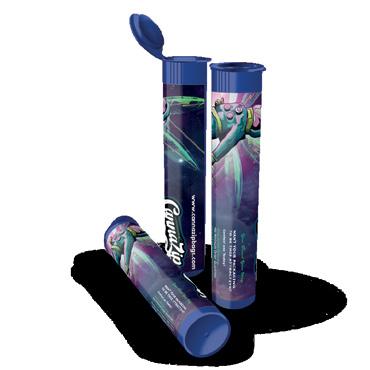












My Bud Vase founder Doreen Sullivan is transforming cannabis accessories into collectible art.
By Aron Vaughan
Smoking devices have come a long way in the past few decades. Along with the rise of dry herb and concentrate vaporizers, bongs and pipes have become more ornate, balancing art and function. My Bud Vase has taken his a step further by creating truly unique smoking pieces that fit as naturally as a centerpiece on a coffee table as they do in a college dorm room.
For My Bud Vase founder Doreen Sullivan, My Bud Vase represents a labor of love born from her background in entertainment marketing and product development—skills she’s deftly applied to this burgeoning luxury cannabis brand. In an exclusive interview, Sullivan shared insights into how she managed to turn My Bud Vase from a small-scale, hidden art project into a celebrated luxury lifestyle brand.

pieces that could transform into “leading ladies” of her collection. Initially, this was a low-cost venture, allowing her to test her creative ideas without significant financial risk.
“My Bud Vase began as an art project,” Sullivan recalled.
What started as a hobby grew out of her desire to repurpose antique vases into functional cannabis paraphernalia. Leveraging her expertise in global product development, she sourced vases at estate sales, carefully selecting
“My initial investment strategy was minimal because I was working within a legal gray area,” she said, referring to other marketing projects. By keeping her startup costs low, she found herself with a product that offered both form and function, without the burden of large upfront investment—a crucial step for anyone entering a high-risk, regulation-heavy industry.
By 2020, Sullivan’s background in product development paid off in the most unforeseen
way. “We became essential,” she noticed, referencing how cannabis sales surged during the COVID-19 pandemic.
Already, Sullivan had carefully cultivated a loyal customer base, one that appreciated the blend of artistry and subtlety My Bud Vase offered. Demand soared, and by August 2021, the brand had reached its first million in sales, setting a pace for a record year.
However, Sullivan’s financial strategies weren’t traditional. Rather than seeking investor capital early on, she opted to bootstrap her operations. This meant reinvesting her revenue directly into inventory, distribution, and marketing. She doubled down on the brand’s signature product lines, producing designs that appealed to both cannabis enthusiasts and those who might enjoy the piece as a decorative vase.
Seizing the Creative Edge in a Competitive Market
In an industry saturated with low-cost, massproduced items, My Bud Vase emphasizes quality and unique craftsmanship—a risky approach that requires careful financial planning. But for Sullivan, this emphasis on







creativity and design serves as the cornerstone of her brand.
“The industry doesn’t always invest in creativity,” she explained. “There’s a lot of thrown-together products.”


Sullivan’s approach is different. Each product tells a story, from her “Mermaid” series that supports ocean conservation to her “Turtle” piece inspired by a month-long journey through various national forests. In financial terms, these product lines stand out in the market, creating higher perceived value, which she noted has driven her brand to become one of the most
collected cannabis accessories on the market.
While My Bud Vase had momentum, the path wasn’t smooth. Scaling up meant Sullivan needed to navigate the complexities of an international supply chain, a common challenge for small businesses but particularly daunting in the cannabis industry. She described a pivotal moment when she faced unexpected roadblocks:
“I had two containers seized at port, amounting to $1.5 million in product.”
Federal agents flagged the items as cannabis paraphernalia, even though, as Sullivan clarified, they were technically vases with small holes—still functional as decorative items. This misinterpretation cost Sullivan both inventory and operational stability, forcing her to relocate her distribution center to Las Vegas.
Despite these setbacks, Sullivan remained resilient.
“I had to shift resources rapidly and rent out my home,” she recalled. “I self-funded, liquidating personal assets to rebuild my inventory.”
This resilience, she believes, is critical to running any cannabisadjacent business, where regulatory uncertainty continues to loom over even compliant operations.
While traditional revenue goals focus on units sold or margins, My Bud Vase tracks success a bit differently.
President


Vice Presidentt



“For me, it’s about becoming collectible,” Sullivan shared.
“When customers own four or five of our pieces, that’s a relationship.”
By curating collections and periodically releasing limited editions, she fosters brand loyalty while ensuring her products maintain value and uniqueness. It’s an approach that resonates with an audience drawn to novelty and personalization—a demographic Sullivan knows well, as she considers herself a lifelong cannabis consumer.
However, Sullivan isn’t solely focused on high-end collectors. Part of her strategy involves offering a range of products at different price points. By creating


affordable yet elegant options alongside her pricier items, she caters to a broader audience while maintaining brand exclusivity.
As she noted, “It’s important to provide something beautiful and functional for everyone, regardless of budget.”
Looking forward, Sullivan is positioning My Bud Vase to evolve beyond cannabis accessories. Her vision? A lifestyle brand that caters to the modern, designconscious consumer, with pieces that fit seamlessly into home decor. She’s already begun experimenting with thematic “sets,” like the “Fiesta” collection, which pairs her signature bongs
with complementary accessories like ashtrays and trays.
“I want to offer complete experiences, transforming cannabis consumption into something elegant and inviting,” she said.
Sullivan knows the path to growth requires additional capital and strategic partners, but she’s cautious about compromising her creative control. She’s looking for partners who understand the importance of maintaining the brand’s artisanal roots.
“I need a team that will let me do what I do best—design, create, and innovate,” she said.
In an industry where utility often overshadows aesthetics, My Bud Vase has pioneered a new narrative, treating cannabis products as collectible art. Sullivan’s journey underscores a critical takeaway for cannabis entrepreneurs: success requires a balance of passion, resilience, and creative financial management. While many rush to scale through external funding, Sullivan’s choice to bootstrap and maintain ownership has allowed her to stay true to her vision.
As Sullivan builds her brand, she’s challenging the conventions of the cannabis market, proving that financial success and artistry can coexist. ❖






DeSantis and the hemp industry take a victory lap after defeating cannabis legalization.

By Paul McKay
As the dust settles from Florida’s Proposition 3 defeat, Governor Ron DeSantis and the state’s hemp industry are likely savoring what can only be described as a political and economic victory. What began as an odd pairing between a conservative governor and an industry profiting from THC loopholes has resulted in a decisive blow to the legalization of recreational cannabis for adults in Florida. The outcome marks a win for the pro-hemp lobby and leaves cannabis legalization advocates nursing their wounds— and perhaps reconsidering their strategies for the future.
DeSantis’s Calculated Win
Governor DeSantis, never shy about his stance on recreational cannabis, framed the failure of Prop 3 as a triumph for Floridian values and “public decency.” His opposition, cloaked in rhetoric about protecting small businesses, concealed the more complex reality: by preserving the status quo, DeSantis effectively upheld the hemp industry’s hold over the market, shielding it from the encroachment of full-blown cannabis legalization.
This stance wasn’t without benefits for the governor. DeSantis’s veto of a bill this past summer, which would have tightened regulations on hemp, positioned him as a “protector of small business”—or, depending on your point of view, as a governor in sync with the economic interests of Florida’s THC loophole beneficiaries. Aligning with the Florida Healthy Alternatives Association, the state’s prominent hemp trade group, allowed DeSantis to appease a well-funded ally. His campaign coffers now bear the fruits of this alliance, with contributions rolling in from industry players eager to maintain the status quo.
The Hemp Industry’s Self-Preservation Tactics
To hear the Florida hemp industry tell it, Prop 3 was a David-versus-Goliath battle. They warned that passing Prop 3 would spell doom for small hemp businesses, squeezing them out of the market as recreational cannabis rolled in, backed by big players like Trulieve. But for all the rhetoric, this is an industry well-versed in
capitalizing on gray areas. Its players have made a tidy profit selling unregulated intoxicants like delta-8 and THCa, and they weren’t eager to see recreational cannabis, with its potential for stricter oversight, come in to disrupt their cash flow.
The irony runs deep here. While Florida’s hemp executives painted themselves as champions of small business, they’ve profited heavily by pushing products with THC-like effects, often with fewer safety regulations than Florida’s medical marijuana. Opposing Prop 3 meant the hemp industry could continue selling their “legal highs” without the competition from a regulated, recreational cannabis market. Their post-victory stance is less about protecting Floridians and more about protecting the bottom line.
“His opposition, cloaked in rhetoric about protecting small businesses, concealed the more complex reality: by preserving the status quo, DeSantis effectively upheld the hemp industry’s hold over the market, shielding it from the encroachment of full-blown cannabis legalization.”
and the “Mom-and-Pop”
Throughout this saga, the hemp industry’s portrayal of itself as a victimized “small business” network clashing with Trulieve—the state’s largest medical marijuana company—has felt disingenuous at best. Yes, Trulieve backed Prop 3, seeing recreational cannabis as a logical next step. And yes, they’re a major player with substantial resources. But Florida’s hemp industry isn’t exactly full of mom-and-pop shops, either. Plenty of these “small” businesses are well-established operators reaping profits from the unregulated sale of delta-8 THC, a
product that conveniently skirts Florida’s medical marijuana regulations.
The irony in the hemp industry’s portrayal of itself as the little guy against “big cannabis” is, in essence, a carefully curated marketing ploy designed to preserve their market share.
Political Machinations and the Future of Cannabis in Florida
In the lead-up to the vote, the Republican Party of Florida, with the help of Evan Power, a lobbyist for the Florida Healthy Alternatives Association, doubled down on their grassroots opposition to Prop 3. Backed by industry money, they circulated materials throughout Florida, stoking fears about recreational cannabis and framing the issue as a matter of public safety. While DeSantis and his allies claimed they were working to protect Floridians, this campaign bore all the hallmarks of a power play designed to keep the hemp industry unchallenged by recreational cannabis.
So, what now? For advocates, the road to cannabis legalization in Florida just got steeper. The well-funded lobbying efforts and political alignments that thwarted Prop 3 show how formidable the opposition can be, especially when economic interests and political capital converge. If another push for legalization is in the cards, it will need a strategy capable of breaking through this entrenched alliance between conservative lawmakers and the thriving hemp industry.
In the end, Prop 3’s failure is a clear reminder that when it comes to cannabis legislation in Florida, money talks, and power protects itself. Governor DeSantis and the hemp industry may insist they’ve acted in the public’s best interest, but it’s hard to ignore the lingering question: was this about safeguarding the public or safeguarding profits? As it stands, Floridians will have to wait a bit longer to see recreational cannabis come to the Sunshine State. In the meantime, those profiting from the loopholes and market monopolies have a clear message: Florida may be open for business, but only on their terms. ❖
By Aron Vaughan
As cannabis continues its march toward mainstream acceptance, both in medical and recreational markets, product safety has become a paramount concern. The cultivation and processing of cannabis inherently introduces risks of microbial contamination. Pathogens like Aspergillus, Salmonella, and E. coli can compromise consumer safety and derail cultivation efforts. Rad Source Technologies, a pioneer in non-gamma irradiation, has developed cutting-edge solutions to address these issues.
Founded in 1997, Rad Source built its reputation by advancing non-invasive decontamination technologies. Traditionally used in pharmaceutical and medical industries, their proprietary QUASTAR X-ray platform is now addressing an increasingly pressing need in the cannabis sector: reliable microbial decontamination that maintains the integrity of the plant.
“Rad Source created this market and has continued to lead and innovate,” said George Terry, Executive Vice President of Rad Source. “The cannabis industry faces significant challenges with microbial contamination, and we saw an opportunity to leverage our proven QUASTAR platform to offer cultivators a reliable, non-invasive solution that ensures product quality without compromising safety or integrity.”
Cannabis, like any agricultural product, is susceptible to contamination during cultivation, processing, and storage. High humidity levels and organic matter create an ideal environment for microbial growth, particularly molds, yeasts,

and harmful bacteria. For medical cannabis patients with compromised immune systems, contaminated cannabis can pose serious health risks. Even recreational users expect products free from potentially harmful microbes.
Additionally, the legal cannabis market must comply with stringent safety standards set by regulators. Failing to meet these standards can result in rejected batches, financial losses, and reputational damage. This is where decontamination methods come into play.
Traditional approaches, such as heat treatments, ozone exposure, or chemical washes, can compromise the cannabis flower’s quality by degrading terpenes, cannabinoids, or the physical structure of the buds. Rad Source’s QUASTAR X-ray platform, however, avoids these pitfalls, offering an innovative alternative.
The QUASTAR X-ray platform employs “Photonic Decontamination,” a non-invasive process that targets microbial DNA without introducing heat or chemicals. The X-ray wavelengths penetrate the cannabis flower to deactivate pathogens at their genetic level, leaving them non-viable and unable to reproduce. Unlike other methods that physically alter the plant, Rad Source’s technology allows the flower to retain its cannabinoids, terpenes, and trichomes.
“We normalize the microbe at the DNA level, instead of the molecular level, leaving it nonviable,” explained Terry. “This means the cannabinoids and terpenes—the compounds responsible for the plant’s therapeutic and sensory qualities—remain intact.”
And, along with eliminating harmful pathogens, this method preserves the sensory and therapeutic qualities of cannabis so the buds remain potent and flavorful.
Unlike heat-based methods, which can degrade the delicate compounds in cannabis, x-ray technology works without raising the temperature of the flower. This ensures the trichomes, which house cannabinoids and terpenes, remain undamaged.
The patented Dose Carousel ensures that each batch receives consistent and uniform radiation. This eliminates the risk of untreated “hot spots,” which can occur with less precise methods.
QUASTAR achieves a 99.9% microbial decontamination rate, meeting or exceeding
safety standards across states and countries. It is particularly effective against molds and bacteria commonly found in cannabis.
Rad Source offers solutions tailored to different operation sizes. Smaller growers can use compact systems, while large-scale producers benefit from high-capacity setups designed for efficiency.
“The system’s precise dose control and uniformity ensure that every batch is treated thoroughly,” Terry said. “Our technology consistently achieves microbial levels that meet the most stringent safety regulations.”
Rad Source’s journey into the cannabis market is a natural evolution of its legacy in other industries. From decontaminating pharmaceuticals to sterilizing medical equipment, the company has honed its X-ray technology for applications that demand precision and reliability. When they turned their attention to cannabis, they saw an opportunity to address a critical pain point with a proven, scalable solution.
“Photons are a tried-and-true method in the medical decontamination world,” Terry said. “There is a reason why Rad Source holds over 90% of the X-ray segment of the cannabis market—it works.”
In addition to cannabis contamination technology, Rad Source offers consultation, training, and ongoing support to ensure producers maximize the value of their investment. Systems like the RS 420∙Q+ are optimized for mid-sized cultivators but can be scaled to accommodate operations of any size.
“Our team works closely with growers to integrate solutions tailored to their production volumes and workflow needs,” Terry said. “Whether it’s a smaller operation or a large-scale producer, we ensure the same high level of efficiency and effectiveness.”
While they continue to refine their cannabis decontamination systems, the company is also exploring new applications for their QUASTAR technology in other industries. Their focus remains on providing sustainable, non-invasive solutions that prioritize safety and quality.
“Our vision is to continue leading the way in safe, innovative, and sustainable X-ray technology,” Terry shared. “As the global demand for safer, cleaner solutions grows, Rad Source will remain at the forefront, delivering trusted technologies that make a difference.”
The cannabis industry’s rapid growth brings
both opportunities and challenges. As more consumers demand safe, high-quality products, technologies like Rad Source’s X-ray platform will play an essential role in setting industry standards. By addressing microbial contamination without compromising the plant’s integrity, Rad Source is helping cultivators meet regulatory demands while delivering products that meet the expectations of discerning consumers.
In the words of Terry: “Let’s get real. Ozone, RF, and other outdated methods don’t protect your flower. Our QUASTAR platform is built on science and decades of expertise. It works, and it makes a difference.” ❖

Cannabis’s automation revolution is taking packing methods from manual to high-tech.
By Alain Vo
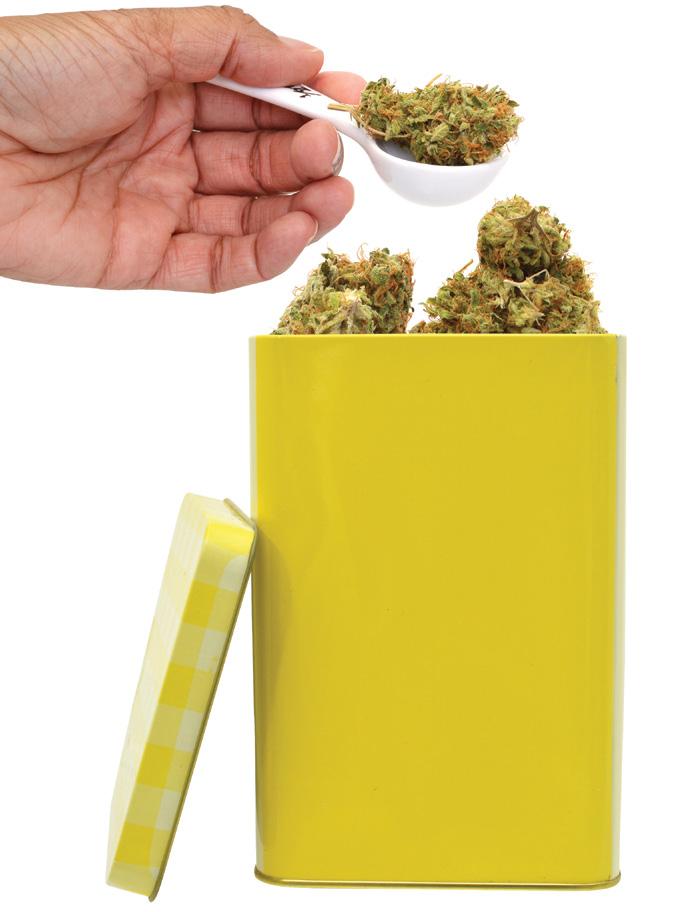
In 2021, just 10% of cannabis cultivation operations used automation technology for packaging.
Yet in 2024, over 80% of cannabis cultivators are moving toward utilizing automation to streamline processes and reduce costs, particularly for plant trimming and packaging.
What led to the 70% jump in just three years?
The widespread recognition of the benefits of automation, to start. When it comes to packaging, automation ensures consistent product packaging and labeling, which, in turn, helps brands stay compliant with regulations. More than that, automated packaging increases productivity, improves operational efficiency, and allows employees to move into value-adding roles such as customer service or quality control.
As major cannabis trailblazers adopt automation for packaging (or for any process, for that matter), other operations with the objective to scale will follow in their footsteps. These benefits, coupled with the realization that automation is no longer a luxury but a need for cannabis operations, have led to the inception of the Anti-Hand Packing Movement.
Photos: iStockphoto.com
Packaging is labor intensive. And this isn’t just a cannabis industry issue; it’s the same for many startups, including those in produce, beef jerky, and candy.
Whereas cannabis is all about community and culture, the Anti-Hand Packing Movement honors this sentiment while promoting the benefits of automation in cannabis. This movement is educating and uniting cannabis cultivators and operators on what automation really is and how it can streamline the packaging process.

The Anti-Hand Packing Movement is the Future of Cannabis Packaging
Often, a cannabis operation’s biggest point of contention is packaging. Operators are always concerned about a slow packaging process without the right technology. This is why it’s no surprise that today, 40% of cultivators consider automation for production processes valuable.
Today’s cultivators understand the critical role technology plays in improving operational efficiency.
Cannabis packaging can no longer be a manual process—not with the growing demand for cannabis products as more states legalize adult recreational use of the plant. That being said, I believe we will soon see a trend towards packaging that supports even higher-speed automation. This includes using materials like film, various types of jars and caps, and more unique rigid packaging styles.
When automation is the key to scalability and productivity, there is no going back to manual packaging systems or any situation that would slow down production.
So the question now is, will you be joining the Anti-Hand Packing Movement in the near future? ❖

Manually packaging cannabis products is like that episode of “I Love Lucy” when Lucy and Ethel are working on an assembly line at the chocolate factory and can’t keep up with how quickly the chocolates are being produced. There is just too much product for a team of 5-12 people to package each day.
This process is inefficient, inconsistent, slow, and riddled with errors. Many times, manual packaging leads to inaccurate weight, misplaced labels, poorly sealed bags, mislabeled jars, and even inconsistent dosages.
The Anti-Hand Packing Movement is a shift away from manual headaches and a push toward maximized efficiency and output.
With an automated packaging system, operators can double or triple their output in a day. One company used to produce 2,500 packaged tins in master cases per day, manually. Once they added an automated packaging machine into their operations, the company was able to package upwards of 10,000 within a day with just a single operator.

Letting online shoppers ghost your dispensary could cost you $300K a year.
By Ryan McMullen
It’s happened to all of us. We browse around an eCommerce site like Amazon, put a pair of flip-flops in our shopping cart, the phone rings, we forget what we were doing, and end up not making a purchase.
A few hours later, an email from Amazon hits our inbox with the subject line: “You Forgot Something.” When we open the email, it’s a picture of the same flip-flops (in the same color) with a “Complete Your Order” button.
“How do they do that!”
Our buying (or not buying) behavior is extremely common. It’s called “cart abandonment”, which is just a fancy way to describe when a customer adds an item to their shopping cart but does not complete the purchase. Every day, dispensaries that accept orders online lose money because of it.
According to the Baymard Institute, 70.2% of shopping carts are abandoned. To put that into perspective, imagine if 100 customers walked into your dispensary, but only 30 of them bought something. Well, that’s exactly what’s happening with your online sales.
To keep the math simple, let’s say your dispensary is currently taking $100,000 per month in online orders. If you were to put a system in place today that recovers just 10% of the abandoned orders, you would make an extra $120,000 each year.
Now, there are a variety of reasons customers abandon their carts:
•Taxes are too high
• They don’t trust the site with their credit

card information
• The site wanted them to create an account
• The obvious, “I got sidetracked.”
The reasons don’t particularly matter. We can make small changes to the checkout process on the website, but that will only move the needle a little.
However, there is one strategy that has proven to recapture more revenue than all other strategies combined—“shopping cart recovery emails” (like the one Amazon sent about our flip-flops). According to Moosend, 50% of customers will open a cart recovery email, and 50% of those customers will end up making a purchase, for a total of 25% of revenue recovered.
Using the example above, instead of making an extra $120,000 each year with a 10% recovery,
now a 25% recovery turns into an extra $300,000 per year. And the best part? You only have to set it up one time in your email software.
The most effective email setup for cart abandonment, is a 3-email sequence:
1) Three Hours After Abandonment: Looks like you forgot something
2) One Day Later: Just checking in
3) Another Day Later: You’re about to miss out
That’s it. Set it up one time, and you’re in the revenue recovery business.
Very few dispensaries have a cart abandonment sequence set up. They are leaking tens and hundreds of thousands of dollars in lost revenue every year all because they “never got around to it.”
It’s a terrible financial tragedy. And one that should never happen. ❖

By Jim Sanfilippo
Imagine buying a product that promises relief, only to find it ineffective or even harmful. Conversations about labeling are not uncommon within the legal cannabis industry. Recent headlines continue to infiltrate news cycles, highlighting the distrust between popular cannabis brands and consumers. As an industry, we must prioritize consumer safety, brand reputation, and the overall consumer experience by addressing these critical issues head-on.
An alarming number of academic studies and news reports have found that cannabis products are often mislabeled, less potent than advertised, or do not provide the effects their labels advertise. In Nevada, the Cannabis Compliance Board recently issued a public health and safety bulletin over mislabeled cannabis products. In Oklahoma, a testing lab accused dispensaries of selling cannabis products with less THC than advertised. While some may accuse brands of carelessness, the reality is more complex.
Many cannabis products are tested at the time of production, but their potency and other characteristics degrade over time. As a result, these products often no longer match the claims made on their labels within 60 to 90 days. If not addressed, the consequences of continuing to put mislabeled products on the shelves could be severe, including class action lawsuits, product recalls, and loss of consumer trust. Our neighbors in Canada have seen nearly 70% of cannabis products recalled since 2018 due to mislabeling issues. Fortunately, we can take steps in the U.S. market to counteract similar problems.
The cannabis industry is not the first, nor will it be the last, to face these challenges. Food and pharmaceutical companies often encounter class action lawsuits for false label claims, allergen
Find out why 70% of Canadian products were recalled and how the U.S. can avoid the same fate.

contamination, and other discrepancies. Under the regulation of federal agencies like the Federal Trade Commission (FTC) and the Food and Drug Administration (FDA), regulations are put in place, and labeling laws are enforced, setting a standard for all to follow. With federal legalization on the horizon for cannabis in the United States, uniform regulations will likely be instituted to ensure labels accurately reflect products during their entire shelf life and will become standard. Additionally, the sector could adopt asepticmodified atmosphere packaging, similar to the food and medical industries, to preserve product integrity and extend shelf life to a year or more, thereby ensuring shelf life stability, freshness, and label accuracy.
Beyond the food and pharmaceutical industries within the U.S., we can also look to the European Union’s handling of cannabis in general. The EU has instituted stringent pharmaceutical-grade standards under Chapter 5.1.4 of the European Pharmacopoeia, resulting in safer and more consistent products. In contrast, the U.S. has a more fragmented approach with varying state regulations on the microbial load that is allowable in each state. Adopting a more unified and rigorous standard similar to Europe’s could benefit the U.S. cannabis industry and maintain consumer trust.
Cultivators must prepare adequately for the forthcoming regulatory measures and practices. With federal legalization, there will be uniform enforcement of labeling standards, addressing the current fragmented regulatory environment. Industry leaders need to recognize these future changes and prepare for them to ensure compliance and maintain consumer trust.
Companies must also invest in access to the equipment needed to utilize modified
atmosphere packaging. This technology allows products to have longer shelf lives and increases satisfaction for consumers and patients.
Above all else, we must hold the cannabis industry to the standards our consumers deserve. Failure to do so could create distrust between cannabis enthusiasts and legal cannabis brands that can take weeks, months, and even years to improve.
The importance of accurate labeling can be boiled down to a five-letter word — trust.
Trust takes years to build, seconds to break, and forever to repair. It may be cliché, but it’s true. Adult-use consumers and medical patients rely on a product’s label for potency and composition, usage and dosage, safety and quality, aroma profiles, allergen information, and other essential details. Without accurate labeling, consumers with allergies may not avoid products that cause adverse reactions, and patients may not receive the correct strains and formulations needed for specific health conditions, such as chronic pain, anxiety, or insomnia.
Accurate labeling is a cornerstone of consumer empowerment and building trust in any industry; the cannabis sector is no exception. The road to industry-wide accurate labeling may not be seamless, but it’s necessary. As a young industry, we have the opportunity to learn from established sectors to maintain consumer trust and safety, and by emphasizing the importance of accurate labeling, we can ensure the growth and sustainability of the cannabis industry.


A cannabis lifer makes the case for swapping America’s punishment-first prison system with AI-driven justice and Nordic-style rehab.
By Ismael Lira
My name is Ismael Lira, and I have been incarcerated for over 20 years of a life sentence for cannabis. I was convicted and received a life sentence in connection with the transportation and distribution of cannabis.

Despite 24 states decriminalizing cannabis for recreational use, 40 states, three territories, and the District of Columbia legalizing cannabis for medical purposes, our federal legislature remains steadfast in its refusal to decriminalize the substance. This obstinate stance not only contradicts the will of most American states but also underscores an archaic attitude that fails to serve the nation’s citizens. Rather than fostering progress and aligning with contemporary societal norms, the justice system seems entrenched in punitive measures aimed less at rehabilitation and more at prolonged incarceration.
The resulting impact is not limited to those

convicted of cannabis-related offenses. It is symptomatic of a broader approach where the justice system appears more focused on ensuring that anyone convicted of any crime serves the maximum sentence allowable by law. This punitive mindset has been fueled by laws that progressively increase incarceration lengths, often stemming from lobbying efforts backed by influential groups such as the Federal Bureau of Prisons Corrections Officer Union.
One of the most chilling aspects of the current system is the “trial penalty,” which refers to the significant disparity in sentence length between those who accept plea bargains and those who exercise their constitutional right to trial. This right, routed in the Sixth Amendment, becomes a costly gamble wherein pursuing justice can inadvertently lead to a much harsher punishment.
Compare that with Nordic countries, such as Norway and Sweden, where the justice system prioritizes rehabilitation and reintegration. These nations boast lower incarceration rates, shorter sentences, and greater emphasis on reintegration, ultimately leading to less recidivism. In stark contrast, the United States has not seen a corresponding decrease in crime rates despite its higher incarceration rates and lengthier sentences, suggesting a need to reassess the humanitarian aspect of justice.
Artificial Intelligence (AI) presents a transformative opportunity to address human biases and agendas within the justice
system. AI has the potential to ensure a truly fair and full consideration of each case, free from prejudices that may cloud human judgment. Innovations in AI technology offer the promise of a more equitable legal system.
For example, AI-driven programs can analyze vast amounts of legal data to identify patterns and inconsistencies, offering insight that can help prevent wrongful convictions. Additionally, AI has been used to predict recidivism risks, aiding in developing personalized rehabilitation programs that can reduce the likelihood of re-offense. Thus, they focus on the individual rather than a one-size-fits-all punitive approach.
Nevertheless, the criminal justice system is often resistant to change, hesitant to cede authority to AI systems that could challenge the status quo.
As we look toward the future, it is imperative to embrace AI’s role in fostering a fairer justice system. By leveraging technology to mitigate human error and bias, we can move closer to a model of justice that prioritizes rehabilitation and reintegration, much like our Nordic counterparts.
The words of Enlightenment thinkers resonate with our modern quest for justice. Voltaire famously stated, “It is better to risk saving a guilty person than to condemn an innocent one.” This sentiment echoes the principle that the justice system should err on the side of caution, prioritizing the freedom of the innocent over the punitive excesses currently dominating. ❖

Compiled by C&T Today Staff

As we move into 2025, Oregon’s love affair with cannabis is as strong as ever, continuing to blend culture, community, and commerce.
The state’s cannabis market is a dynamic one, reflecting a unique mix of highs and lows that echo its ever-pioneering spirit. Over the past year, sales have hit peaks—like the big December 2023 holiday rush— and seen dips, notably in January 2024. But the market’s steady resilience is clear: as of October 2024, sales totaled nearly $80 million, with flower taking the top spot despite slightly lower prices.
Compared to other states, Oregon remains competitive, offering some of the most affordable prices on flower, prerolls, and edibles. Enthusiasm for cannabis here remains strong, driven by a wellestablished consumer base and a steady stream of newcomers looking for quality, affordable options.
Through ups and downs, Oregon’s cannabis industry keeps pushing forward, fueled by a dedicated consumer base and a deep-rooted cannabis culture that’s here to stay.

In the thick of Oregon’s wild cannabis market, Alibi Cannabis leans on craft, science, and a little escape to thrive against the odds.

Oregon has a reputation as one of the most mature and competitive cannabis markets in the United States. Since legalizing recreational cannabis in 2014, Oregon has experienced rapid growth, with many small, independent cultivators entering the scene. However, the market has also faced a series of challenges, including price compression due to an oversupply of cannabis, resulting in slim profit margins for many businesses. Oregon’s unique regulations, coupled with the state’s reputation for top-tier cannabis, push producers like Alibi to stay innovative and consistent in quality to rise to the top in a crowded field.
“Operating in Oregon requires us to be lean and agile,” said Todd Meredith, Alibi Cannabis’ head of sales and co-founder. “The market is really, really challenging. Oversupply and compressed prices lead many cannabis companies to go out of business each year.”
Founded by Marianne Cursetjee in 2017, Alibi is a craft cannabis
company rooted in Oregon’s longstanding culture surrounding the plant and Cursetjee’s personal journey, which led her to explore cannabis after a battle with breast cancer.
Despite many pressures, Alibi remains resilient, focusing on craftsmanship and consumer trust to stand out in the mature Oregon market.
Operating out of a 10,000-square-foot indoor facility in the Portland area, Alibi has designed its cultivation process around a hands-on, craft approach. This scale allows Alibi to maintain control over every aspect of the growing process, from hand-trimming each bud to carefully curing every batch to perfection. Head grower Lacey Thomas, with her background in botany and plant pathology, brings a scientific rigor to Alibi’s operations that is uncommon even in Oregon’s technically advanced cultivation paradigm.
“I spend a lot of time learning precision watering techniques,

meets shifting preferences. It’s a challenge to balance the cost of testing and packaging small batches, but it’s worth it to ensure consumers have options.”
Alibi’s “Mariposa” icon—a woman with butterfly wings—is intended to symbolize transformation and wellness, echoing Oregon’s values around personal growth and natural healing.


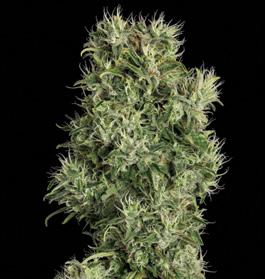
studying graphs, and dialing in the environment,” she said.
Originally focused on a select few cultivars, Alibi has expanded its genetic library to keep up with the evolving Oregon market. Now, the company rotates through about 30 strains, aiming to harvest five unique varieties each month. This rotation provides Oregon consumers with diversity on dispensary shelves, balancing variety with the high costs of small-batch testing and packaging.
“Oregon consumers are wellinformed and expect variety,” Cursetjee said. “We maintain about 30 different genetics in our mother room to offer a range that
“The ‘Mariposa’ represents what cannabis can bring to the world,” Cursetjee explained. “It’s about finding your best self and escaping to a better place, even if just momentarily.”
This concept ties into the company’s name, “Alibi,” which they chose for its connotation of providing an alternative reality—a moment of escape.
“You can say to yourself, ‘I’ve had a bad day, so I’m going to smoke a joint and be somewhere else, somewhere better, where there’s joy and calm,’” Cursetjee said.
Rather than being seen as merely a recreational substance, Alibi is focused on presenting cannabis as a means to enhance well-being and explore new states of consciousness.
As Oregon’s cannabis story continues to be written, Alibi— and others like it—are redefining what it means to thrive in this wild, ever-changing industry. ❖




Meet the company swapping infrared for green light to keep Oregon’s cannabis plants safe, healthy, and thriving—no scorched leaves required.
Oregon’s cannabis industry is always pushing the envelope with fresh ideas and sustainable practices. One of the most interesting examples of this innovation comes from InfraGreen Systems, a company based on the idea that cannabis security should protect plants without compromising their health. InfraGreen Systems is one of those innovators, designing cameras that blend security with plant-friendly technology— meeting the specific needs of cannabis growers in a way that traditional security equipment doesn’t.
It might seem odd to think about light as a potential enemy of cannabis plants. But for years, the cannabis industry has had a complicated relationship with infrared (IR) light. Traditional security cameras often use IR for night vision, which allows security teams to keep an eye on facilities after dark. But it turns out that cannabis plants can be sensitive to prolonged exposure to IR light, and growers have seen everything from scorched leaves and foxtailing to wilting and wasted plants.
InfraGreen Systems saw an opportunity here. Rather than sticking with IR, they shifted focus to green light, a gentler
option that cannabis plants tolerate far better. Their flagship product, the Green Diamond 12MP security camera, uses green light, which helps maintain plant health while still allowing for effective monitoring.
Green light helps growers monitor crop health in a unique way. When cannabis plants are healthy, they reflect green light, appearing vibrant and uniform in color. But if there’s an issue—like mold, damage, or stress—the light reflects differently, making the problem areas darker and easier to spot on camera.

So, with the Green Diamond camera, growers keep an eye on security and catch early warning signs of plant issues.
Oregon has carved out a reputation as a hub for craft cannabis and sustainable practices, which makes InfraGreen Systems’ approach a natural fit. Cultivators here value plant health and ecofriendly methods, and they’re more inclined to adopt tech that promotes both. By eliminating the need for IR light and using a green-light system instead, InfraGreen Systems offers growers
a way to save on energy and equipment costs, while reducing potential harm to their plants. This is a win-win for a state that prioritizes environmentally conscious cannabis practices.
InfraGreen Systems’ tech isn’t just good for growers; it’s a small but meaningful step toward more sustainable cannabis operations in Oregon. The company’s approach helps reduce the industry’s reliance on energy-draining IR lighting and standalone greenlight setups, which adds up over time in terms of energy savings.
In an industry that’s constantly
adapting to new regulations and grappling with strict quality standards, Oregon’s cannabis growers have had to get creative to stay competitive. InfraGreen Systems offers one such inventive approach, taking a unique angle on cannabis security that doesn’t compromise plant health. By using green-light technology instead of the traditional infrared, InfraGreen gives growers a tool to protect their crops and keep their energy use in check. It’s an approach that speaks to the heart of Oregon’s cannabis scene— blending sustainability with innovation in a way that keeps the state’s cultivation values front and center. ❖


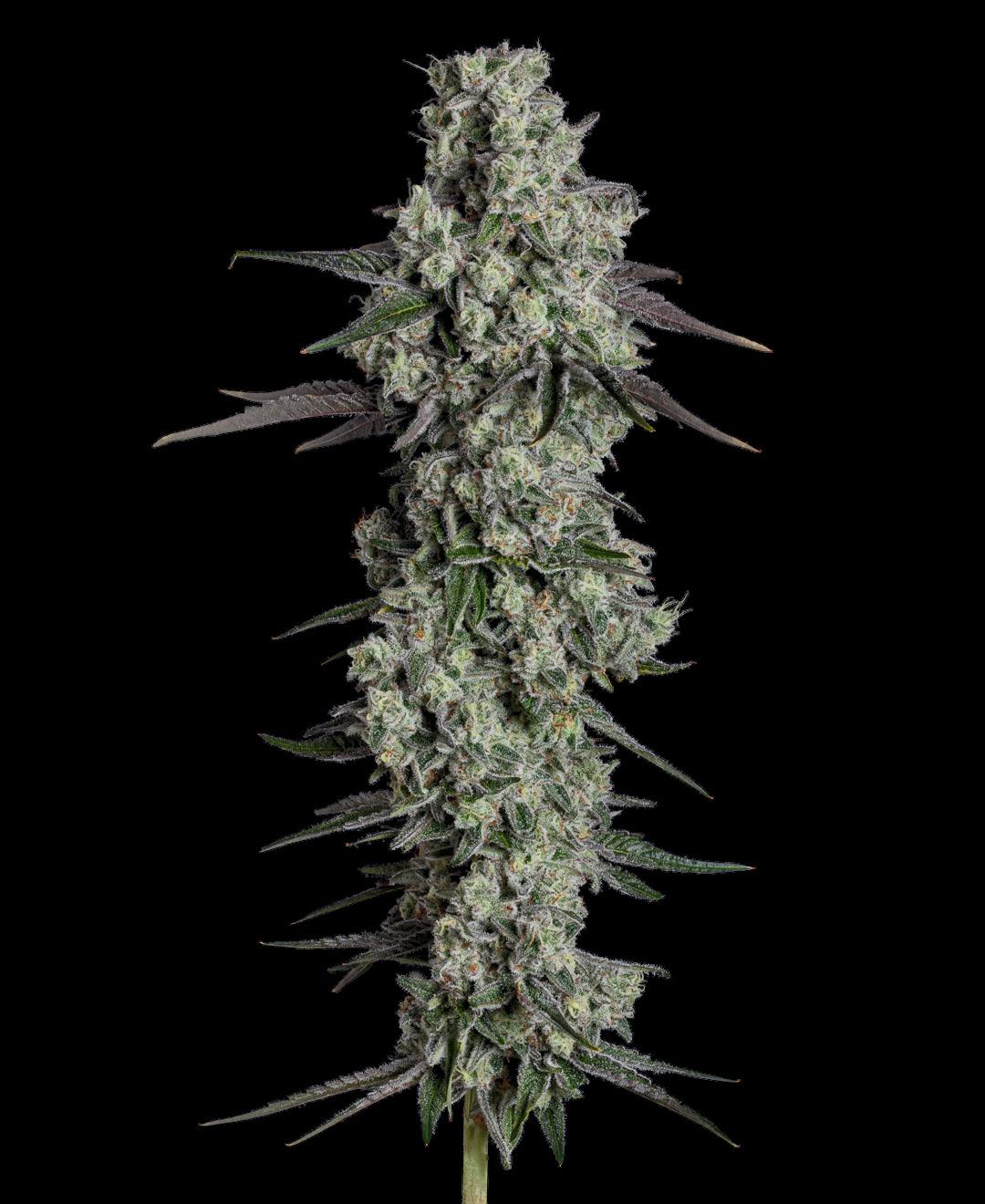


From dorm-room hacks to a best-selling product, Brandon Shroyer’s Smoke Trap is transforming how people enjoy cannabis discreetly and sustainably.
Brandon Shroyer’s entrepreneurial journey began in an Oregon college dorm with a DIY filtration hack we all know and love—a toilet paper roll stuffed with dryer sheets. It wasn’t perfect, but it sparked an idea. By 2016, as Oregon legalized cannabis, Shroyer saw an opportunity to create a discreet and efficient way to manage cannabis smoke and odor, eventually leading him to found Smoke Trap. With his father’s support, Shroyer initially tried his hand at growing cannabis but soon pivoted to developing an accessory he saw as a real need for an effective, portable smoke filter.
From Deodorant Sticks to 3D Printing Prototypes
Creating the Smoke Trap was no small feat. Shroyer’s early prototypes included deodorant sticks filled with pantyhosewrapped filters, tested out during what he calls “R&D sessions” with friends. Through trial and error— and countless hours on a free 3D printer at his university—Shroyer refined his idea into a sleek, userfriendly design. Six months after graduation, Smoke Trap officially launched, catching on quickly through affiliate marketing and social media.
Customer feedback shaped the evolution of Smoke Trap, especially its popular Smoke Trap Plus model. Shroyer learned from early adopters that they wanted

better airflow, longer filter life, and less clogging. His solution was a larger filter about the size of a coffee mug that balanced portability and effectiveness.
“People were asking for something that lasted longer and was easy to use,” Shroyer explained, noting that a key upgrade was adding a hydrophobic screen to keep moisture from clogging the filter.
Eco-Friendliness at the Forefront
Beyond usability, sustainability became a defining feature of the Smoke Trap. Unlike disposable filters, the Smoke Trap Plus uses recyclable, replaceable filters, reducing plastic waste.
“At the time, creating a reusable, eco-friendly filter was a new concept,” Shroyer reflected.
“Cannabis accessories weren’t usually designed with

sustainability in mind, but I wanted to make something people could use long-term without throwing away plastic.”
A Nationwide Appeal
Though based in Oregon, Smoke Trap’s appeal isn’t limited by geography. Shroyer’s customers range from urban apartment dwellers to college students nationwide, all seeking a discrete solution for indoor smoking.
“People think legalization reduces the need for discretion, but that’s not necessarily true,” Shroyer said. “If you’re in an apartment, you still want to keep things low-key.”
As a one-man operation, Shroyer has learned to navigate the challenges of a maturing cannabis market. Despite advertising restrictions on cannabis-adjacent products, Smoke Trap’s non-
Smoke Trap founder Brandon Shroyer’s entrepreneurial journey began in his Oregon college dorm room.

cannabis classification allows it to reach a wide audience. Shroyer’s formula for ongoing success consists of three major components: focus on quality, prioritize customer service, and keep innovating.
“Cannabis is competitive, but the fundamentals of business don’t change,” he said.
In an industry focused on sustainability and responsibility, Smoke Trap’s reusable filter offers a fresh take on cannabis accessories. Shroyer’s journey from a DIY dorm filter to a competitive, eco-conscious product highlights a unique aspect of the cannabis culture—the creativity and innovation of young entrepreneurs. With plans to keep evolving his designs, Shroyer is proving that something as simple as a smoke filter can have a big impact. ❖











Oregon’s hemp pioneer is going global.
Oregon’s cannabis industry has long been a pioneer, crafting quality products while challenging perceptions around plant-based medicine. At the heart of this movement is Laurelcrest, a McMinnville-based, family-owned business redefining hemp’s role in wellness. Since 2018, under the guidance of company President Danielle Bernstein, Laurelcrest has grown from local roots to a global powerhouse, exporting custom hemp solutions to over 2,000 clients in 14 countries.
According to Bernstein, Laurelcrest’s mission extends far beyond commerce.
“Our primary goal is to advance the industry, advocating for collective legalization and ensuring safe, effective plant-based products are accessible,” she explained.
Laurelcrest strives to reframe hemp as a tool for wellness rather than simply a recreational substance.
“In the long run, I play a small role in a decades-long movement to legalize and de-stigmatize this plant,” Bernstein shared.
Innovation with Integrity
Laurelcrest’s impressive, GMPcertified 18,000-square-foot facility in McMinnville embodies the company’s mission of striving for quality and transparency. From raw cannabinoids to finished product solutions, Laurelcrest maintains rigorous standards, including thirdparty testing, USA-grown hemp, vegan certification, and a steadfast focus on compliance.
“We gauge our success through customer trust and satisfaction,” said a Laurelcrest spokesperson.
Bernstein’s recent trip to Thailand, where she connected with traditional plant-based healing, reinforced her vision for Laurelcrest’s future. Attending a cannabis conference in Bangkok, she explored the region’s rich medicinal history, meeting a family whose baby found seizure relief through safe cannabinoid treatment.
“Experiences like these are reminders of the true medicinal potential of cannabis that should guide our industry’s future,” Bernstein reflected.
In Thailand, where cannabis is being embraced as a medicine again, Bernstein discovered untapped opportunities in wellness tourism, a global sector projected to reach $1.37 trillion by 2028.
“Thailand could certainly lead the
world in producing plant-based medicines, blending Eastern and Western medicinal approaches,” she shared, underscoring the broader economic and cultural benefits of a medicinal approach to cannabis.
As Laurelcrest expands, they remain steadfast in their mission of accessibility, ethics, and innovation. Oregon’s cannabis scene thrives on innovation, but it’s companies like Laurelcrest that ground the industry in purpose and authenticity. From McMinnville to Bangkok, Bernstein’s leadership is shaping plant-based medicine’s future with a thoughtful blend of tradition and progress.
For Laurelcrest, the path forward is about legacy, bridging cultures, and honoring the healing potential of cannabis on a global scale. ❖







From childhood magic tricks to a worldwide community, Josh Kesselman built RAW Rolling Papers by chasing an “unfiltered” vision in every roll and spark.
By Aron Vaughan
Photos by Proven Media
In the world of rolling papers, few brands can claim the loyal following, cultural significance, or global reach of RAW.
Spearheaded by Josh Kesselman, RAW’s journey from a college head shop to a worldwide cultural phenomenon began decades before the brand’s official 2005 launch. With an early passion for collecting rolling papers that started at just five years old, Kesselman rose to create one of the most innovative rolling papers in the world while simultaneosuly building a community dedicated to the art and experience of rolling.
The story of RAW begins with a magic trick. At just five years old, Josh watched in awe as his father performed a seemingly simple yet mesmerizing illusion. Using Spanish rice-style rolling papers, his father would light one, throw it in the air, and it would vanish.
“I can still remember that moment, the table, even the broken glass look of my grandma’s mirror,” Josh recalled.
That trick ignited a lifelong
fascination with rolling papers, one that would later define Josh’s career and passion that would only grow through the years.
Collecting rolling papers became more than a hobby for Josh; it was an obsession. Growing up in New York and Long Island, as soon as he was old enough he bought every new paper he could find in head shops, building a massive collection. To Josh, these papers were more art than simple tools.
Their intricate designs, historical roots, and cultural significance captivated him. His early trips to head shops introduced him to a community of free spirits, where he found inspiration among the long-haired, open-minded owners and patrons who personified the ideal lifestyle.
In the 90s, while still in college, Josh opened his first head shop in Gainesville, Florida. With a modest monthly rent of around $450, Josh launched his store without a grand plan or extensive retail experience. Instead, he let his passion and the preferences of the community shape the shop’s
offerings. “I would carry what customers suggested,” he said. Each time someone asked if he’d stock their favorite product, he would promise to have it within two weeks. The store flourished, becoming a hub for the loyal community.
It wasn’t long before Josh’s store gained a boost from international rolling paper collectors. He began trading with European collectors, swapping common American papers for boxes of unique European brands. This experience taught him a crucial lesson about the market: the appeal of premium, distinctive rolling papers was universal. Josh’s store continued to thrive, but a 1996 incident involving the sale of a bong to the daughter of a U.S. customs agent changed his path. A raid ensued, and though his rolling papers were deemed legal, Josh decided it was time for a new beginning in a more-like minded state. He relocated to Phoenix, Arizona, then a hotspot for cannabis culture, where he refocused his business almost exclusively on exotic rolling papers.

The turning point in Josh’s journey came through an unexpected connection. In his childhood, he’d been enchanted by a brand his father had used, Marfil Arroza Spanish rice paper with a distinctive feel and quality. Years later, Josh learned that a Spanish paper factory once produced these papers but had since closed after litigation from a huge American tobacco company. Fortuitously, Josh connected with Jose Emilio, a passionate Spanish paper maker who had managed to acquire and preserve machines and workers from that original factory. Despite the language barrier, Josh and Jose bonded over their shared love for rolling papers. Jose’s family had produced Marfil papers for generations, and together they decided to revive this legacy.
The result was Elements, a
brand that encapsulated the natural elements used to create the paper. Elements found success, but Josh’s drive pushed him further. With Jose’s mentorship and the factory’s historical knowledge, Josh was ready to create his own very custom brand. Elements was followed by Juicy Jays, a line of flavored papers named after a nickname Josh had earned in high school.
The concept for RAW came to Josh during a particularly frustrating moment with a customer who had raved about a “natural” cigarette brand. When Josh tried it, he was appalled by its bleached white, calcium-filled paper. That experience planted a seed for what would eventually become RAW—a rolling paper that was as pure as possible, with minimal additives.

“I wanted it to be like the tribal experience of throwing hemp on a campfire,” he said.
Creating RAW wasn’t easy. The paper industry was skeptical about Josh’s vision of a translucent, naturally unbleached rolling paper with minimal additives. After a series of rejections, a small mill finally agreed to take on the project for the base sheet. Josh took a huge financial risk, putting his savings into massive rolls of that base sheet which would become RAW rolling papers. After years of fine-tuning, RAW launched officially in 2005. The papers were an almost instant hit, resonating with smokers who appreciated the brand’s authenticity and intense focus on quality.
RAW’s early success spread through “sesh circles,” a passtime we all remember with great
nostalgia. These circles, which Josh considers the heart of RAW’s rise, helped the brand grow organically. By offering samples to anyone who seemed genuinely interested, Josh ensured RAW found its way into circles worldwide. Over time, these sessions connected the globe in what Josh describes as a “giant sesh circle,” where RAW papers became synonymous with the greater cannabis community.
Over time, the RAW brand evolved to become more than just another rolling paper brand, embodying the virtues of quality, craftsmanship, and attention to detail. Josh’s obsession with perfection extends to the smallest elements, such as the “fold line” of each paper, which he feels must be just right to ensure an even burn.
“I’m probably the only one who

cares about that fold line,” he admitted, “but if it’s not right, the experience isn’t perfect.”
RAW’s Spanish factory is where the magic happens. Modernized with state-of-the-art machinery yet steeped in the traditions of old-world craftsmanship, the factory combines the best of both eras. One machine, dubbed “La Bicicleta,” still has handlebars, pedals, and a horn, a nod to its origins as a hand-cranked machine. RAW’s production includes machines like “The Symphony,” a high-tech apparatus with multiple processes in one, which personifies how Josh has merged innovation with a respect for the past.
Throughout the rise and proceeding dominance of social media, RAW has managed to stay relevant without compromising its authenticity. Josh attributes this to
his genuine passion for the product and his eagerness to share it with others.
Social media became a platform for him to educate smokers on the history and nuances of rolling papers, dispelling myths and preserving the craft’s heritage. Though, according to Josh, many of his early videos were “annoyed storytelling” to debunk inaccuracies, he ultimately saw them as a way to connect with the RAW community.
The RAW brand voice is distinct, speaking directly to a community that values transparency and authenticity. RAW’s social media strategy revolves around storytelling and education rather than conventional marketing.
Beyond business, Josh has remained deeply committed to social causes. Through RAW
Giving, the brand has donated over $3 million to organizations focused on criminal justice reform, homelessness, animal welfare, and entrepreneurship. Notably, in 2024, RAW donated $200,000 to the Last Prisoner Project and $100,000 to the Weldon Project, both of which support individuals affected by cannabis-related offenses. Additional donations went to animal shelters and emergency housing programs in Arizona.
Josh believes that “true wealth is what you give away,” a philosophy that guides RAW Giving’s mission. He vets every donation personally to help ensure each dollar goes toward making a meaningful impact. In the aftermath of a huge lawsuit victory, he pledged to donate the net proceeds to causes that align with his vision for social justice and community improvement,
Inspired by a childhood fascination with rolling papers, Josh Kesselman founded RAW in 2005, creating unbleached, natural papers and building a global community.
and has recently made good on that promise.
“RAW Giving has saved and improved the lives of so many beautiful humans,” Josh said.
The Legacy of RAW
As RAW continues to expand its offerings, including recent innovations like the RAW Classic Phatty Papers, the brand remains dedicated to its roots. He sees himself as a link in a long chain of artisans, preserving the art of rolling papers for future generations.
“Someone after us will make better [papers] than us,” he said.
“That’s the way humanity has always been.”
As RAW’s sesh circle continues to grow, Josh remains committed to his simple yet profound mission: to make his best rolling paper possible and share it with the world. ❖
By Aron Vaughan
As the mastermind behind the offbeat cult hit Wilfred, Jason Gann may have first won us over with laughs, but today, he’s dead serious about cannabis, mental health, and social change.
Jason Gann, widely recognized for his creation of the irreverent and beloved TV show Wilfred, has forged a path from entertainment to the cannabis industry and political advocacy, aiming to reshape cannabis culture and legislation in Australia.
Gann’s career has taken him from dressing as a dog to running a cannabis brand, all while pursuing a unique mission to destigmatize cannabis and unlock its potential for mental health, healing, and even planetary preservation. From launching his own cannabis brand to running for office, Gann is committed to rethinking cannabis culture, legislation, and its potential to heal both people and planet.
Initially, Gann viewed Wilfred, the dark comedy where he donned a dog suit and confronted life’s absurdities alongside Elijah Wood, as purely entertainment. However, he soon realized the profound impact the show had on viewers.
“I discovered when I was making the American show just how much of an impact the Wilfred character had in a lot of people’s lives,” he reflected. Over time, fan stories of how Wilfred helped them through difficult times and even “saved their lives” prompted him to see the series in a different light.
This recognition of Wilfred’s unintended role in mental health advocacy led Gann to feel a sense of duty to address cannabis and its potential benefits seriously.
“I had what I would say was a calling when I was a teenager,” he said, referring to an early belief that he would someday be involved in a world movement with political impact. With


Wilfred serving as a vehicle to destigmatize cannabis and mental health issues, Gann now views his cannabis activism as the “completion” of that calling.
After years in Hollywood, Gann found himself drawn to the evolving cannabis scene and eventually established Wilfred Cannabis in California. His brand has garnered attention for its novel approach to cannabis consumption by focusing on the benefits of all parts of the plant rather than chasing the highest potency. One of his products contains delta-8 THC, a less potent cannabinoid than delta-9 THC, allowing users to experience a mellow psychoactive effect without the paranoia or anxiety that traditional cannabis can sometimes induce.
Gann has spoken about the medicinal benefits of delta-8 THC, sharing stories like that of an Afghanistan veteran who found that Wilfred Cannabis products were the only option that didn’t trigger his PTSD.
“A lot of people say to me, ‘I would love to be able to smoke weed, but I just get too paranoid,’” Gann explained.
By providing alternatives, he hopes to make cannabis accessible to those who might otherwise avoid it.
Through Wilfred Cannabis, Gann is challenging the cannabis stigma and offering an approachable entry point for newcomers who may feel intimidated by conventional cannabis products. His aim is to bridge the divide between medicinal and recreational use, advocating for cannabis as both a source of enjoyment and a tool for healing.
Returning to Australia, Gann encountered a cannabis landscape far different from the progressive legalization he witnessed in the United States. The Australian cannabis market remains limited, with only medical cannabis permitted under tightly controlled regulations. While some may see recreational legalization on the horizon, Gann remains cautious.
“I actually think it’s unlikely to happen anytime soon,” he admitted.
He sees Australia as slow to embrace change in the cannabis sector, bound by stigmas that link cannabis to crime and addiction.


One of Gann’s chief frustrations is the inaccessibility of local cannabis. Due to regulatory barriers, the Australian market relies heavily on imported products, often of inferior quality.
“We’re getting Canada’s leftover crap,” he said bluntly, describing imported cannabis that often fails to meet quality standards.
Meanwhile, skilled Australian cultivators remain sidelined, criminalized despite their expertise. Gann advocates for legislation that would allow these growers to participate in the legal cannabis market, calling for a “cannabis amnesty” to end the criminalization of local
cultivators and create a more sustainable, highquality supply chain.
Gann’s vision goes beyond the business of cannabis; he aims to change how it’s perceived in Australian society. He’s faced what he sees as an orchestrated effort by media and pharmaceutical interests to suppress procannabis narratives. Citing a study he came across that misleadingly linked cannabis to increased suicide risk, Gann recalled, “The article’s headline said the very opposite of what the study concluded. There was no direct link to cannabis and suicidal thoughts.”


For Gann, the distortion of such research is emblematic of a larger bias against cannabis.
“The Australian media and governing powers seem committed to keeping the cannabis conversation negative,” he argued. “Most Australians never see alternative perspectives, and that creates a society that’s unaware of cannabis’s benefits.”
Gann has taken the extraordinary step of exploring a run for Australian Parliament with the goal of influencing cannabis policy at the federal level. “I’m not getting in the dog suit for that one,” he joked. But the prospect of bringing his knowledge of cannabis and its legislation from the U.S. to Australia is serious business for him.
“I have a voice, and I intend to use it,” he said.
The Cannabis Code: A Spiritual and Historical Exploration
Beyond the political and business realms, Gann’s relationship with cannabis has a deeply spiritual aspect. He’s currently working on a documentary project called The Cannabis Code, which delves into the ancient and mystical history of the cannabis plant.
“My relationship with cannabis is spiritual,” he explained. “It really helps me. It’s very healing for me.”
The documentary will explore cannabis’s role as a sacred substance used by ancient cultures to connect with higher powers. Gann was fascinated to learn about the Dogon tribe of North Africa, who believe that extraterrestrials gifted cannabis to early humans to expand consciousness. Gann, who claims a personal experience with extraterrestrials in 1997, finds these historical narratives compelling as they resonate with his own belief in cannabis as a spiritual ally.
The project reflects Gann’s view of cannabis as a plant that offers “shelter, food, and medicine” and has a mysterious component that science has yet to fully explain.
“Plants are incredibly intelligent,” he said, referencing recent studies that suggest plants may possess sentience. “Cannabis is the only plant that does all three: shelter, food, and medicine. And then it has this extra spiritual element.”
The Cannabis Code aims to highlight

cannabis’s hidden histories and explore its potential as a healing agent for individuals and the planet alike. Through this documentary, Gann hopes to inspire viewers to reconnect with nature and reevaluate the cultural narratives around cannabis.
“Cannabis has this spiritual component that science and biology can’t define,” he reflected. He sees the film as his contribution to a broader movement, aiming to “set people’s imaginations on fire,” much like Carl Sagan did with Cosmos.
As Gann enters the political arena, he’s focused on shifting the dialogue around addiction and cannabis. He argues for a nuanced understanding of cannabis as a form of selfmedication for some.
“I’m not the guy that’s going to say cannabis is a miracle drug with no side effects,” he admited, acknowledging that misuse can occur, especially with high-potency forms of cannabis. But he also challenges the medical community’s frequent dismissal of self-medication, suggesting that people should have more autonomy over their treatment choices.
Gann is particularly interested in reframing addiction within a context of trauma and
disconnection, believing that cannabis can offer a pathway to healing when used responsibly.
“The third instinct for humans, after food and shelter, is to alter the state of consciousness,” he said. Gann believes cannabis should be seen as one of many tools to achieve this shift, allowing people to find balance and purpose without falling into the cycle of abuse.
Jason Gann’s journey from Wilfred to Wilfred Cannabis and beyond is marked by a consistent desire to challenge norms, advocate for the misunderstood, and connect people with a greater sense of purpose. As he continues his activism and entrepreneurial pursuits, Gann remains focused on the medicinal and spiritual dimensions of cannabis, viewing it as a potential remedy not just for individuals but for society at large.
In a time where stigmas around cannabis persist, Gann’s approach is both refreshing and radical. His story is not just one of transformation as well as a call to action for a society ready to reassess the role of cannabis in health, policy, and personal wellness. For Jason Gann, cannabis is more than a business—it’s a cause, a calling, and, perhaps, the next evolution in a journey that’s only just beginning. ❖
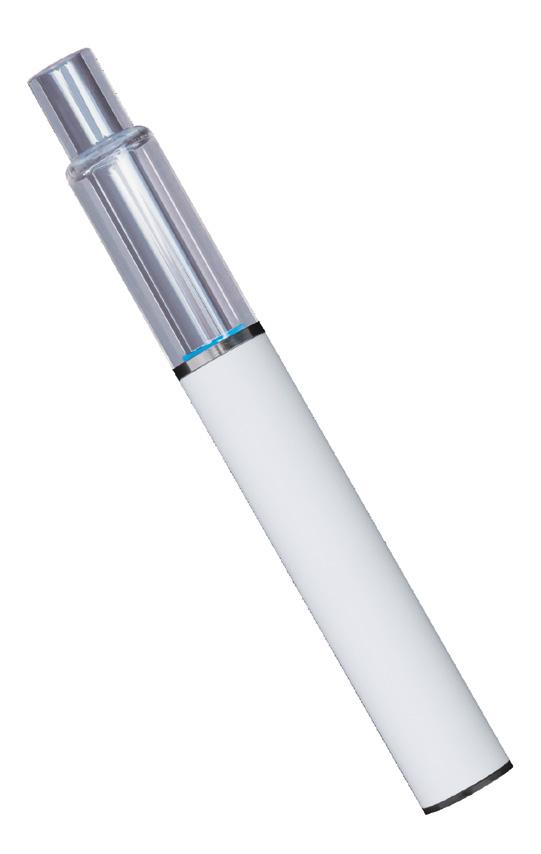





Once rebellious and hilarious, stoner movies seem to have faded into a nostalgic haze as cannabis culture goes mainstream.
By Paul McKay
Stoner movies, once a rite of passage for every cinephile with a sense of humor and a love for the absurd, seem to have drifted into the hazy fog they so often depicted. The golden era of stoner cinema gave us cult classics like Cheech and Chong’s Up in Smoke (1978), Dazed and Confused (1993), and the one-two punch of Half Baked (1998) and The Big Lebowski (1998). Then, of course, came the high renaissance: Harold & Kumar Go to White Castle (2004), Grandma’s Boy (2006), and Pineapple Express (2008). These films were never meant to be Oscar contenders; their charm came from being unabashedly goofy, chaotic, and often politically incorrect. They knew their audience and knew exactly what to deliver—bizarre humor, surreal storylines, and protagonists who thrived on breaking all the rules.
From Cult Classics to Cultural Relics
What made these movies successful was their complete disregard for societal norms. Pineapple Express saw Seth Rogen and James Franco on the run from drug lords in a plot that escalated faster than any viewer could anticipate, while Half Baked offered up Dave Chappelle in all his offbeat glory. These movies tapped into a culture that didn’t take itself too seriously. They were funny because they were real in the most exaggerated, chaotic sense. There was something liberating about watching characters who didn’t care about climbing the social ladder or pleasing the establishment.
Blunt Humor and Blurred Lines
Flash forward to the last decade, and it seems the stoner movie has gone the way of Blockbuster and dial-up internet. Stoner films

today don’t make the box office splash their predecessors did. Movies like The Beach Bum (2019) starring Matthew McConaughey felt like an attempt to revive the genre’s absurdity, yet it failed to make the cultural impact it might have 10 or 15 years prior. Good Boys (2019) attempted to mix raunchy humor with stoneresque adventures for a younger crowd, but it ultimately stayed grounded in the mainstream comedy realm. And then there’s An American Pickle (2020), a Seth Rogen flick that could’ve easily been a stoner classic if it hadn’t tried so hard to shed the “stoner” stigma.
When High Was Edgy
Ultimately, society has shifted its perspective on “the stoner,” especially as cannabis steps out of the shadows and into legalization. The classic image of the lazy, dim-witted pothead has
evolved (thankfully) into a more multidimensional character—someone who works a nine-to-five, hits the gym, maybe even meditates. We’re living in a world where weed culture has gone mainstream, with cannabisinfused dinner parties and marijuana yoga classes. But as marijuana became more socially acceptable, the appeal of the taboo—the very thing that once made stoner movies funny and rebellious—faded.
Today, the stoner movie seems lost in a no man’s land between nostalgia and normalization. It’s hard to find humor in something society no longer sees as edgy. These films are now reflections of a different time, an era when cannabis was both a punchline and a countercultural symbol. Can they find new ground in a world that views cannabis as simply a part of everyday life?
The stoner movie’s charm was that it lived on the edge, playing into the “bad behavior” aspect of weed culture in a way that celebrated rebellion against norms. Now, as that rebellion fades, so does the genre’s allure. It’s a challenge for filmmakers to recreate the irreverent charm of stoner classics in a world where weed has become just another ingredient in wellness products and upscale dinners.
Never say never, but as it stands today, it seems the “stoner” movies we grew to know and love have gone completely “up in smoke.” Only time will tell if this genre can reinvent itself for a new era or if it will remain a nostalgic artifact, like a haze of sweet-smelling smoke drifting into the past. ❖

The most trusted name in B2B Cannabis events since 2014
2025 Convention schedule
Boston, MA March 21-22
Maryland May 2-3
Vermont May 2-3
Florida May 23-24
New Jersey Sept 5-6
Michigan Sep 19-20

Ten years ago, I remember hiding in my bathroom for just a few short moments at a time, clutching my little bong and exhaling out the open window. I was anticipating the inevitable siren call back to the responsibilities waiting for me on the other side of that closed door, bracing myself for the call that the break was over.
“Moooooommyyyy!”
Five. More. Minutes… please.
Susie Homemaker. That was the role I played. I was clocked in 24/7, spending all my time raising babies, keeping up with the house, and preparing meals on a repetitive loop that never seemed to end. I slept with tiny elbows and knees digging into my back or shoving me off the bed, showered with the curtain wide open while Lego sets or baby dolls were played with on the bathmat in front of the tub, and hid in my bathroom to smoke weed, convincing myself I loved this role I was playing. I told myself I loved being Susie Homemaker, that I loved the life I was living.
But I didn’t.
In those moments of toking refuge behind that closed door, I was only keeping the constant creeping feelings of anxiety, depression, and loneliness at bay so I could muster the strength
to continue in my denial. While I love my kids and being their “mommy” more than anything on this planet, I was never built to be that kind of mom.
And guess what? That is perfectly OK.
A decade later, I find myself fully embracing the kind of mother I have always been meant to be. So long, Susie Homebaker, and say “hello” to Susie Stonedbaker, kids. The days of bathroom bong-hiding are long gone.
I’m no longer spending my days keeping up with the house or changing diapers. For the last six years, I have been lucky enough to call myself an employee of the legal cannabis industry. In this space, I’ve found myself surrounded by women and mothers who reject the taboo and negativity surrounding moms who smoke weed. Instead, we proudly wear the “canna-mom” badge for all to see, including the kids.
Yeah, you heard me right. Including the kids.
I’ve never hidden behind closed doors to give myself a bolus of insulin. I’ve never felt like I had to shield my kids from seeing me check my blood glucose, and I’ve always openly and honestly answered their questions and curiosities about my juvenile diabetes. Marijuana is my medicine, and using it has
From secret bathroom tokes to proud cannabis advocate, a diabetic mother sheds light on the ‘canna-mom’ movement.
By Jamie Lynn Dodd
always been crucial in helping me face the adversities and challenges of my health, both physically and mentally.
The stress I face in raising my children, working full-time, managing my diabetes, and just existing in our day-to-day lives plays a large part in my health. High volumes of stress can lead to fluctuating blood sugars and a variety of other issues. I’ve always found marijuana to be the most effective remedy for keeping those dangers away.
Call it mother’s intuition, but from the moment I began my career in cannabis, I knew I had to be as open and honest with my children about this plant medicine as I’ve always been about everything else I use to sustain my health. I’ve educated my kids about this medicine to the best of my ability, feeding their understanding and answering their curiosities as they come. I know in my heart that the most important effort I can put forth in destigmatizing marijuana has to start within my own family—and, most importantly, within the young minds of my children.
I’ve never wanted to force the acceptance of how I choose to medicate on others around me, only to nurture it. I never want my kids to feel ashamed or embarrassed by what I do, but
instead, feel pride in the passion I have for advocating for this plant medicine that plays such a large part in my tales of healthcare and motherhood redemption.
We are all lucky enough to be living in the infancy years of what I believe to be the Renaissance age of cannabis, and to stand in this space in tandem with motherhood is a truly beautiful place to be. This plant itself is the embodiment of feminine strength and power. It even exists as both a “child” and “mother” in its lifetime, facing adversities and challenges—a living testimony to the same formidable strength that calls upon those of us women who chose the path of motherhood.
There has never been, nor is there still, any kindness in this world when it comes to being female or being a mother. To bear the love and responsibility of raising my children will always be the most gratifying role I have been lucky enough to fulfill in my life, while also being the hardest. It is the duty of society to uplift and empower the women filling this role with acceptance and love, and the same should be said for this plant medicine.
In the midst of this Renaissance, we have the most extraordinary opportunity to paint its Golden Age with streaks of green by embracing and emboldening the acceptance of the “canna-mom” era.
Every mom’s journey with cannabis is unique, shaped not only by her needs and beliefs but also by her will to find empowerment. As our stories unfold, they remind us that motherhood, like cannabis, is nothing short of a beautiful display of resilience and courage. It is finally our time to redefine what it means to be a strong and empowered parent—and to embrace the Susie Stonedbaker kind of mother that some of us are truly meant to be. ❖
“I’ve always found marijuana to be the most effective remedy for keeping the dangers of stress-related health issues at bay.”
Photo: iStockphoto.com
Fentanyl is sneaking into street cannabis, making the underground market more dangerous than ever before.
By Dr. Benjamin Caplan
Fentanyl is a synthetic opioid approved for medical use as a painkiller. It is also illegally sold as a street drug. Notorious for its lethal potency, even the smallest amounts, akin to a couple of grains of sand, can be enough to cause a deadly overdose.
Individuals who are exposed to fentanyl-contaminated products may initially experience:
• Euphoria
• Hallucinations
• Drowsiness
• Confusion
• Dizziness
• Constipation
• Nausea and vomiting
• Muscle rigidity
• Reduced drive to breathe
These symptoms can escalate to severe shortness of breath, loss of consciousness, or even coma. In the event of an overdose, and without prompt medical intervention or the administration of Narcan (naloxone), a drug that can reverse fentanyl’s effects, progression can culminate in cyanosis (a bluish discoloration of the skin due to poor circulation or inadequate oxygenation), hypotension (light-headedness due to low blood pressure), bradycardia (abnormally slow heart rate), and death.
Fentanyl can also severely compromise the medicinal nature of cannabis in managing pain, inflammation, and sleep disorders. It binds with the powerful opiatesensitive system of receptors in the body, blocking cannabis molecules from these same receptors and thereby blocking the known healing benefits, including reducing inflammation, limiting the excessive signaling of pain, and aiding in relaxation that promotes better sleep.
There have been reports of fentanyl making its way into street cannabis, joining a list of dangerous cannabis additives that include cocaine, PCP, and heroin. The potency and addictive nature of fentanyl, combined with its cheap production costs, may make it an attractive additive for unscrupulous dealers. The unpredictable and concealed dangers make every street purchase akin to a game of Russian roulette.
There is a secure and trustworthy solution: legal, regulated medical and adult-use dispensaries.
State-licensing of storefronts prioritizes consumer safety and product purity by requiring thirdparty testing, which guarantees

products are safe from bacteria, mold, chemical solvents, and other contaminants like fentanyl. In the 38 states that allow medical cannabis programs, accessing medical dispensaries requires a consultation with a healthcare provider.
In the 23 states currently permitting legal access to cannabis, adults aged 21 and over can find a wide variety of safe products. What’s more, individuals who are looking for the therapeutic benefits of cannabis without the “high” can purchase CBD products in many retail stores and on the internet. These products offer a nonaltering yet effective alternative to products containing THC that are regulated.
As a licensed doctor who specializes in cannabis medicine, I create treatment protocols with products for a wide variety of
conditions and ailments, ranging from debilitating pain and depression to severe stress and difficulty sleeping.
I give my patients clear instructions on how to buy, what to buy, and what to take. The number one rule is to never buy cannabis products on the street, or even from illegal cannabis shops that are popping up in cities like New York City, where cannabis is legal, but the availability of regulated dispensaries has been slow to scale.
Street cannabis is not a safe bet. Without stringent testing and quality standards, one can never be sure of a product’s safety or purity. Legal dispensaries offer a transparent and trustworthy alternative. Their commitment to quality assurance and consumer safety justifies the higher product price. ❖





With unreliable lab testing plaguing legal cannabis, home growing offers a safer, smarter alternative.
By Sara Brittany Somerset
The prevalence of disreputable labs within the U.S. cannabis industry is an open secret among insiders. Some labs cut corners to attract clients, reporting inflated THC levels and issuing padded Certificates of Analysis (CoAs) instead of providing honest results. These practices create a competitive disadvantage for labs with integrity and leave consumers at risk.
Ultimately, the consumer pays the price, relying on lab testing that’s more of a marketing ploy than a safeguard. Substandard products with questionable approvals may pose serious health risks, underscoring the urgent need for industry reform.
The Patchwork of Mold and Pesticide Testing
While some states have started cracking down on corrupt labs, enforcement remains inconsistent. For example, the New York Office of Cannabis Management recently allowed vertically integrated cannabis companies to self-regulate mold testing. Such decisions highlight the uneven landscape of safety standards in legal markets.
With varying mold and pesticide testing requirements by state, determining which products are truly safe is a challenge. The lack of standardization leaves a gap that many consumers no longer trust the legal industry to fill.
In response to these uncertainties, more cannabis users are turning to home cultivation—commonly called “home grow.”

Growing cannabis at home allows consumers to control quality and safety from start to finish. With reliable seeds and proper techniques, home growers can produce cleaner, healthier cannabis than what’s often found on dispensary shelves.
The Drug Enforcement Administration (DEA) has clarified that cannabis seeds containing less than 0.3% THC are federally legal, allowing consumers to buy seeds online and begin their cultivation journey.
Tips
Home growing might seem daunting, but it doesn’t have to be. Auto-flowering seeds are a beginner-friendly option that simplifies the process. Unlike traditional cannabis plants, auto-flowering varieties don’t require complex light schedules to thrive.
Royal Queen Seeds, for example, offers a wide range of auto-flowering seeds, while the Humboldt Seed Company guarantees germination and provides high-quality genetics for novice growers. These seeds, combined with guides like Cannabis: A Beginner’s Guide to Growing Marijuana by Danny Danko, make it easier than ever for beginners to succeed.
For those ready to start growing, reputable seed banks offer a variety of options: Humboldt Seed Company: Nearly 25 years of experience producing diverse strains, backed by a money-back guarantee.
Royal Queen Seeds: Over 100 strains,
including easy-to-grow auto-flowering and F1 hybrid seeds.
Blimburn Seeds: A Barcelona-based company with a robust selection of genetics and a new direct-to-consumer model in the U.S.
These companies provide a trusted foundation for growing cannabis safely and effectively.
In states where cannabis remains illegal, consumers can still legally purchase seeds marketed as “adult novelty items.” Advocacy for home grow rights continues to gain traction, as it offers consumers the ability to cultivate high-quality cannabis independently of the flawed legal market.
Steve DeAngelo, Global Brand Ambassador for Blimburn Seeds, emphasizes the importance of this movement: “Mother Nature has endowed human beings with the right to grow cannabis, but a right means nothing without the means to exercise it.”
Until the cannabis industry enforces nationwide standardized testing, consumers will struggle to trust legal products. Home growing presents a viable alternative, empowering individuals to bypass the pitfalls of a flawed system.
As the industry matures, it faces a choice: clean up lab practices to restore consumer confidence or watch as more users take matters into their own hands— seed by seed. ❖



Canncestra CBD Lotion — Born from botanical wisdom and breakthrough science, these formulations shatter industry standards with nearly triple the concentration of conventional topicals. Proprietary transdermal technology drives relief deep beneath the skin, targeting pain at its source. These plant-based formulas deliver results without compromise: vegan, gluten-free, GMO-free, and never animal tested. $50
Quest Climate Dehumidifier — Introducing the redesigned Quest 746 480-volt dehumidifier, engineered for cultivators prioritizing their bottom line. With the lowest amp draw in the industry, this highefficiency unit significantly reduces energy costs, boosting your profit margins. By preventing crop-crushing diseases and pests, it ensures healthier yields and higher returns. Plus, it features Quest-patented M-CoRR Technology, performing at the widest operating conditions to match your grow cycle needs. Invest in the Quest 746 480V and watch your cultivation thrive economically and ecologically. $11,500

PuffCo Peak Smart Rig — The Puffco Peak Smart Dab Rig redefines the dabbing experience with seamless design and unparalleled technology. Ready in just 20 seconds, it offers four precision heat settings to capture every nuance of flavor and potency. Smart temperature calibration and haptic feedback make every session effortlessly smooth. Compact, powerful, and beautifully crafted, the Peak is the ultimate companion for concentrate enthusiasts looking to elevate their ritual to a new level of sophistication. $200


Vaporizer — The VENTY Vaporizer is a powerful, portable device with an impressive 20-liter/minute adjustable airflow, allowing a custom vapor experience. Heating up in just 20 seconds, it combines innovative convection and conduction technology for pure, flavorful clouds without burning. With precise temperature control (40°C - 210°C), Bluetooth connectivity, and rapid USB-C charging, VENTY is designed for efficient, hassle-free use. Enjoy smooth, cool vapor in every draw, making it the ideal choice for dry herb users seeking performance and quality. $449
XR Pure XR12 X-Ray System — XRpure’s X-ray system delivers precise, chemical-free decontamination with over 3-log pathogen reduction, all while preserving cannabinoids, terpenes, and water content. Designed for medium to high-volume operations, the XR12 processes 15-20 lbs. of dried cannabis flower in 2.5 hours. The fantastically simple, reliable design provides years of operation with no fuss. A 16kW version of this machine will soon be released which delivers the same safe and effective results in 40% less time, boosting throughput for high-volume growers. Custom pricing, flexible lease options available.

Green Rebates — Green Rebates Service advocates for cannabis cultivators by managing the entire rebate process at no upfront cost, allowing growers to focus on what they do best, run their operations. Specializing in rebates for energy-efficient grow equipment, Green Rebates simplifies the complex application process to maximize their clients rebate potencial. With over 300 clients served, $55 million in rebates managed, and over 420 million kWh (and counting) saved for clients, Green Rebates helps cultivators reduce costs and improve sustainability without the hassle. Custom pricing

Dialed Out Gummies — Dialed Out Gummies by Dialed In Cannabis are crafted for optimal sleep, blending 5mg each of THC, CBD, and CBN per piece. These açaí berry-flavored gummies utilize a rapid-onset formula, promoting relaxation within 5-15 minutes. Made with full-spectrum solventless rosin and a proprietary sous vide process, they ensure consistent quality and flavor. Each package contains 20 gummies, totaling 100mg of THC, CBD, and CBN, providing a reliable solution for restful nights. $32

Hawthorne Gardening Company Gavita CT2000e LED — Next level power and efficiency. Drawing 650 watts and producing 2000 μmol s-1 PAR @ 3.0 μmol/j, the CT2000e improves output and efficiency versus the CT1900e. Wide, even light distribution, dimmable to 35% with the EL3 controller and simple installation make the CT2000e perfect for HID to LED conversions. Broad white light with a blue enhanced spectrum from premium diodes may enhance terpene and cannabinoid production. Gavita Grown. Start to finish. $1,149


Cryo Cure — Cryo Cure began in Michigan when CEO Tracee McAfee and President Greg Baughman developed a superior method of rapidly drying and curing cannabis. They sought to improve upon freeze drying methods, which left flower overly dry and brittle. What they found was the perfect combination of temperature, pressure, and time required to produce bud that looks, smells, tastes, and feels exceptional. Cryo Cure makes this process available to cultivators of all sizes with its line of drying machines.
Custom Pricing
PULSE USA — The Limited Edition PULSE USA smart battery reads the resistance of your cartridge and auto-adjusts the voltage for optimal vaping. With Vuber’s patented “Never Burn” tech, the PULSE tapers heat as you draw for the best flavor every time. An OLED screen displays battery, resistance, voltage, and wattage. Switch to manual mode to choose from four preset voltages, giving you precise control and a unique vaping experience. $60


Rebel Spirit — Two-time winner of the Oregon Growers Cup, Rebel Spirit prerolls never fail to please. They put two terpene-rich strains in every pack to satisfy customers’ craving for variety. Some smokers prefer hand-twisted cones, and others like machine-rolled “straights,” so Rebel Spirit offers both. Either way, consumers love the easy access to Rebel Spirit’s smooth-smoking award-winning proprietary strains, expertly manufactured for a consistent, steady burn—all brought to you in beautiful, minimalist, biodegradable packaging. Price varies by product.

Reencle Home Composter — The Reencle Home Composter (pronounced “wrinkle”) is an easy-to-use plug-and-play smart appliance that utilizes microorganisms to digest food scraps. Simply unbox the sleek compact unit, the size of an under-desk wastebasket, pour in the included organic compost pellets, add seven cups of water, wait 24 hours, and presto, it is ready to receive banana peels, egg shells, and moldy

digested by the presence of microorganisms, such as glucose and bacillus, turning it into compost, soundlessly and odorlessly. Best of
Mary Jones Soda — Mary Jones HD9-infused craft sodas are created with the exact same formulation of Jones Soda, adapted for HD9 with high-quality, lab-tested THC derived from hemp. The sodas are sold in 12-ounce cans with either 2.5, 5, or 10 milligrams of low dose hemp THC, in four classic Jones’ flavors including Root Beer, Orange and Cream, Green Apple, and Mary Jones’ award-winning Berry Lemonade. $6 per can
washed and ready to fill, reducing producer costs and returns, while delivering “Freshness You Can Hear”—the ultimate standard for quality preservation in cannabis packaging. Pricing varies based on order size.

— The CCELL Rosin Bar is a disposable vape pen designed for rosin and other solventless extracts. It features a 0.5ml tank capacity, a 300mAh battery, and USB-C charging. The device utilizes multi-level heating distribution to atomize cannabinoids and terpenes at optimal temperatures. Its dual oil pathways prevent clogs and burnt tastes, while the isolated airway enhances vapor purity and safety. The Rosin Bar is inhale-activated and constructed with a full metal housing and foodgrade mouthpiece and center post. $8
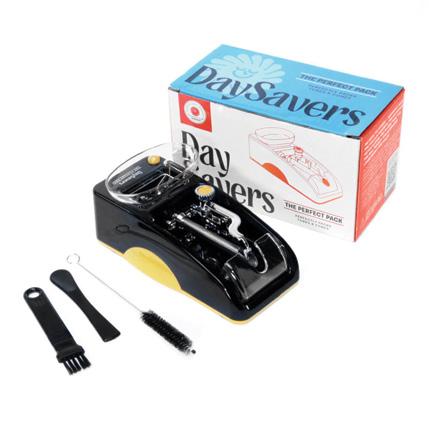
DaySavers Perfect Pack — This cigarette tube-filling machine is mindfully designed to work specifically with cannabis, using a unique screw method for an even, customizable pack. No more fussing with tapping or repacking. With this tool, they can control the compression of their joints from start to finish—now available at select Urban Outfitters locations. You’ll be gifting the convenience of a perfectly packed joint, every time. $35

Cannatrol Cool Cure — This post-harvest system is designed to optimize the drying, curing, and storage of cannabis. Unlike traditional methods, it maintains precise water activity and vapor pressure levels, protecting terpenes, potency, and flower structure. By preventing overdrying, the system ensures higher yield and premium quality buds that remain sticky and flavorful for months. Ideal for both commercial cultivators and home growers, it revolutionizes cannabis processing for consistent quality, peak results, and increased profitability. Starting at $1,600


RIVR — Owned by the Soboba Band of Luiseño Indians, RIVR is a functional beverage born from over 1,000 years of ancestral wisdom. Crafted with a blend of yerba mate and herbal teas, natural ingredients, functional mushrooms, hempderived THC, and adaptogens, RIVR inspires a profound appreciation for the natural world through products delivering true-to-land experiences. The brand’s mission is to honor the Tribe’s resilient spirit, preservation of heritage and community, and their deep understanding of the connection between the mind, body, and land. $51.60 per 24 count case
Muha Meds Infused Pre-Rolls — Muha Meds’ Infused Pre-Rolls elevate the cannabis experience by combining premium indoor-grown flower with proprietary Muha Sauce Diamonds, achieving over 40% THC potency. Each pre-roll is evenly coated with kief and infused with melted diamonds and live resin, ensuring a smooth inhale and flavorful exhale. Available in various strains and flavors, these pre-rolls offer a potent, long-lasting high, setting a new standard in cannabis consumption. $35 per 3 grams

Otto Go Smart Grinder — The OTTO by Banana Bros is an automatic milling machine designed to deliver the perfect grind every time. Utilizing artificial intelligence, it adjusts pressure, speed, and direction based on the material’s texture and consistency, ensuring a uniform, fluffy grind. Compatible with various herbs, OTTO simplifies preparation with its easyto-use design. $70
JANUARY
11-12 | Alternative Products Expo | Lima, Peru
13-14 | SUNY Cannabis Conference | Niagra Falls, NY
29-31 | Total Products Expo | Las Vegas, NV
31-FEB. 2 | 8th Hawaii Cannabis Expo
FEBRUARY
8-9 | Connecticut Cannabis Expo | Plantsville, CT
12-15 | Champs Trade Shows | Las Vegas, NV
28-MARCH 1 | Lucky Leaf Expo Minneapolis | Minneapolis, MN
13 | International Business Conference (ICBC) | Barcelona, Spain
15-17 | Spannabis | Barcelona, Spain
21-22 | New England Cannabis Convention (NECANN) | Boston, MA
21-22 | CANNEXPO | Toronto, Canada
Can’t wait for the next cannabis event? Scan now to discover what’s happening worldwide with the Cannabis & Tech Today Events Calendar.
As the dust settles post-election, what does the new political landscape mean for cannabis? We’ll explore fresh legislative changes that could transform everything from interstate commerce to social equity programs. Industry experts and lawmakers weigh in on what’s next, offering readers an inside look at the policies shaping the future of cannabis across the United States, with a particular focus on Florida—a state on the verge of big moves.
Sustainable practices are at the forefront of this issue, diving into innovative methods like carbon-neutral cultivation and closed-loop systems. We’ll showcase the pioneers who are redefining eco-friendly cannabis production, addressing the urgent need for sustainable growth while maintaining high-quality yields. From start-ups to industry leaders, learn how cutting-edge methods are helping cannabis companies reduce their carbon footprint and lead the way toward a greener future.
Discover the top tech trends revolutionizing cannabis in 2025! Our experts reveal the hottest technologies, from AI-driven analytics to robotics and vertical farming advancements. Plus, we’ll spotlight this year’s C&TT Innovation Award winners, celebrating groundbreaking achievements that could reshape the industry. For investors, this issue is packed with insights into new opportunities in cannabis technology, so you can stay ahead in a market that’s transforming at lightning speed.
Mark your calendars—this is one issue you won’t want to miss!






I have often asked the question among the people I meet, “What’s your favorite candy and chocolate? If you were trapped on a deserted island, which two would you choose to have an endless supply?” My choice of candy is ALWAYS my “Happy Gummies” (recipe found in THE HAPPY CHEF Expert Cannabis Cookbook”) and my choc-olate of choice is “Turtles,” hands down!
One, like myself, can get a tad bored of just making “Magic Chocolates” so to add some extra deliciousness into each treat, include caramel and pecans with a little sea salt for the perfect magical combo! I have many tales enjoyed by these little guys, one told after this recipe in fact! But, before I get into another “Tales From The Trip” let us proceed on through the magic method of creating these adorable little treats!
16 ounce high quality “magic” chocolate (64% cocoa or higher)
*See “Magic Chocolates recipe*
2 cups pecans
6 tablespoons Dee’s Infused Butter with happiness
1/2 cup light brown sugar
1/2 cup coconut sugar
1 tablespoon ground cinnamon
1/2 cup sweetened condensed milk
1/2 cup light corn syrup
1/2 teaspoon vanilla extract
2 tablespoons of sea salt (garnish)
*OR* if wanting a quicker recipe, you can buy pre-made caramels at the market to save time. I just think they taste better made from scratch.
300 grams of chocolate, *either 32% to 36% milk chocolate —or—for a healthy chocolate go 64% or higher in cocoa
25 grams ground magic, *my molds have a net weight of 12 grams per chocolate and I am dosing each chocolate at 1 gram magic making 25 units
2 tablespoons ground cinnamon
#HappyFact: You may quicken this recipe if you do not wish to have the end results be as they are pictured here, by chopping the pecans and adding them into the microwaved caramel in step 6. Then take spoonfuls of caramel mixture and dip them into the magic chocolate placing them on baking sheet lined with parchment paper. *This method is a lot faster, both are delicious!

+ Store your turtles in an airtight container at room temperature, *OR* if you live in a humid climate it is best to store in fridge, for 2-3 weeks. You may store in freezer to increase shelf life up to 3 months. Allow to come to room temperature before serving.
This recipe of “Trippin’ Turtles” is from my cookbook DELIC DISHES: The Happy Chef’s guide to cooking with psychedelics. Shop cookbooks, products & more at TheHappyChef.co! Follow on all social medias @thehappychefco & @ edibledee
MAGIC METHOD :
1. Preheat oven to 350°F (176°C).
2. Make sure to also begin making your “Magic Chocolate” from recipe 27 as that is the magic ingredient to this recipe. *See “Magic Chocolates”.
3. Spread pecans out onto a baking sheet and bake for 5 to 10 minutes, stirring once, until toasted and fragrant. Be careful not to burn. *You may also buy roasted pecans to skip this step.
4. Prepare a separate baking sheet with parchment paper and set aside.
5. Place Dee’s Infused Butter in a large microwave safe bowl and heat in microwave until melted.
6. Add brown sugar, sugar, cinnamon, sweetened condensed milk, and corn syrup and stir well to combine.
7. In a separate bowl, fill with ice water and set aside.
8. Return large bowl from step 4 to microwave and cook on high power for 5 minutes. *May require a minute or two longer depending on your microwave.
9. Use oven mitts to safely remove the bowl from the microwave. Spoon a small spoonful of the caramel into the bowl of ice water. Use your fingers to pinch the caramel - it should form into a pliable ball (not to soft, but not to firm). If it is more on the firmer side, return to microwave for an additional 30 second, and test till it’s pliable.
10. Stir in vanilla flavor to caramel mixture.
11. You can either form the caramel into the head and body of the turtle (mi nus the legs) to get the shape as photographed in this book, or you can spoonful the mixture directly on to the parchment paper to create individual mounds of caramel candy. I usually total the “bodies” to make 24 doses with my batches, however you can make the candies as small or as big as you like, just remember - these are dosed. *dose to your desired level)
Refrigerate until set, about 25 minutes.
12. After the caramels are set, on a separate lined baking sheet pour a table- spoon of magic chocolate in circles (disks, like pancakes) evenly spaced apart about 2 inches. Take your pecans and form them into an X sizing them a bit larger than your caramel bodies setting them so the end (or the feet) are stick- ing out of the chocolate. *These are your legs for your turtles. Let chocolate set about 2-3 minutes.
13. Place each body of caramel atop the legs and top, or coat the caramel body covering with magic chocolate. Let set another 2 to 3 minutes and top with sea salt. Store in fridge to set completely another 5 minutes. Serve and #GetHappy! PREP : 30 COOK : 25
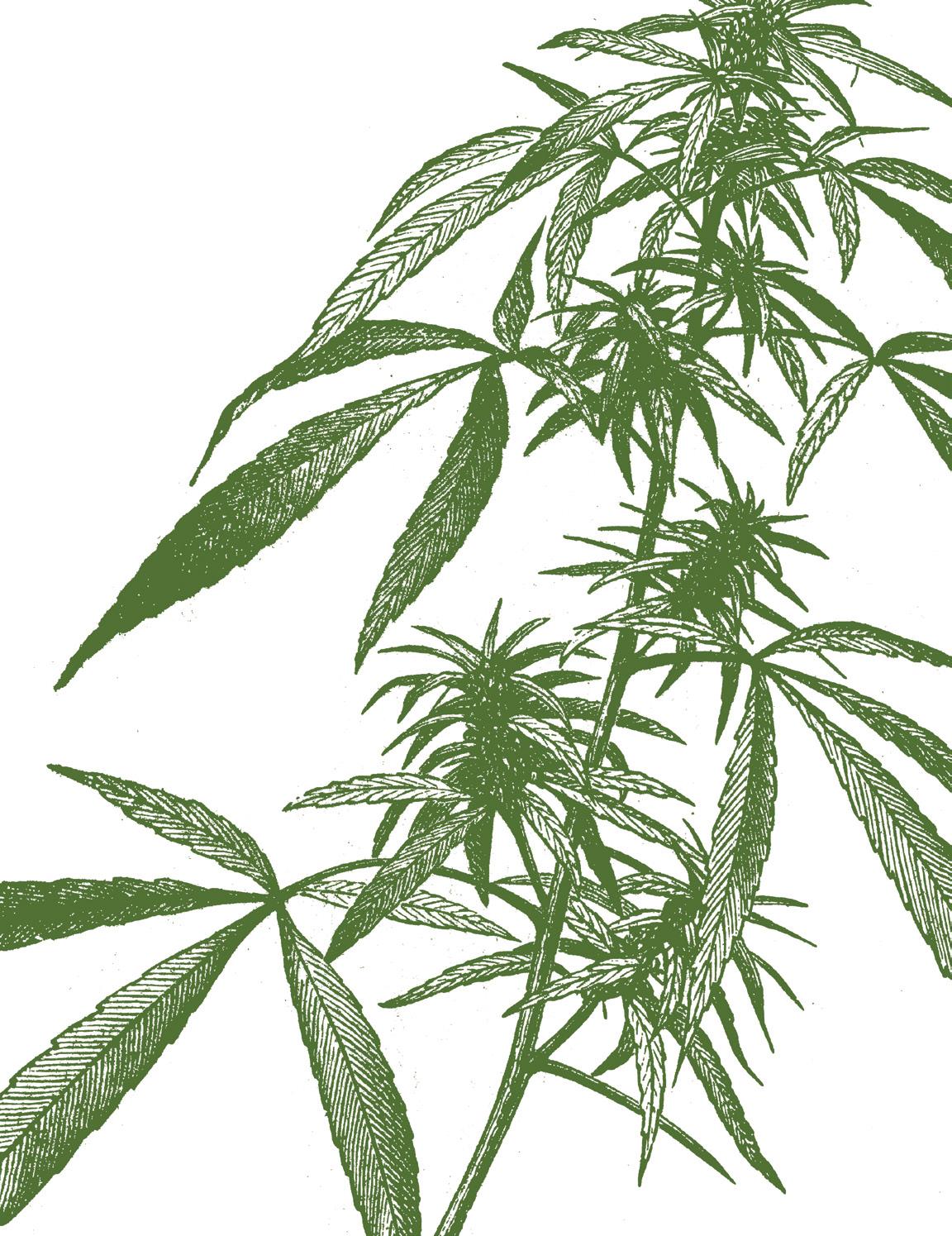
Once upon a time, in a quiet countryside, there lived a boy named Jack and his mother on their small, failing dairy farm. The farm used to thrive, but with people opting for almond milk, soy milk, and every milk but the one from their cows, the business had taken a nosedive.
One particularly desperate day, Jack’s mother sighed, “We can’t keep up like this, Jack. There’s only one cow left, and we’ve no money to feed her or ourselves.”
With a heavy heart, Jack took their last cow to the market, hoping to sell her and keep the farm afloat for just a little while longer. But when he returned home, instead of money, Jack proudly held up three strange seeds.
“I traded the cow for these magic seeds, Mom!” Jack exclaimed.
His mother’s face turned a deep shade of red. “Magic seeds? You traded our last hope for seeds?”
Before Jack could explain, his mother snatched the seeds and hurled them out the window in frustration. “Magic seeds! What a joke!”
They went to bed hungry that night, both too upset to speak to one another.

When Jack awoke, he noticed an odd shadow creeping through his room. He rushed to the window and gasped.
“Mom! Look at this!”
There, where his mother had thrown the seeds, grew an enormous weedstalk. The stalk was thick, towering into the clouds, covered with pungent buds that smelled… surprisingly familiar.
His mother gawked at it in disbelief. “What on earth?”
Jack’s curiosity got the best of him. “I’ve got to see where this goes.”
His mother protested, “Jack, it’s dangerous! You can’t just climb some… oversized weed plant!”
But Jack was already on his way up, gripping the thick, sticky stalk as he climbed higher and higher until the house below disappeared into the mist.
When Jack finally reached the top, he found himself in a strange land high above the clouds. Before him stood a massive castle. He hesitated.
“Maybe this was a bad idea,” Jack muttered. But something caught his eye. Near the entrance of the castle was a goose with shimmering golden feathers on its tail. And right beside it, a golden egg!
“If I can just grab that goose,” Jack whispered to himself, “we’ll be rich. No more worrying about the farm.”
Jack crept toward the goose when the ground beneath him shook. THUD. THUD. THUD. The sound grew louder until a giant figure appeared.
Every story Jack had ever heard about giants was absolutely terrifying, from eating people whole, to tearing them in half just for fun. Jack’s heart raced and he quickly ducked behind a bush and waited until the coast was clear.
Too terrified to try again, Jack decided he would climb back down the weed stalk and come back tomorrow with a master plan. As Jack shimmied back down the stalk he couldn’t help but notice something miraculous, his yard had now been filled with dozens and dozens of smaller weed stalks! Pineapple express, sour diesel, white widow, girl scout cookies and all of the best strains known to man were growing as far as the eye could see! Jack then decided he knew exactly how to celebrate. He quickly picked a few freshly grown buds and started rolling joints to help him with the “creative process” while he came up with his master plan.
The next morning, Jack woke up with a mixture of excitement and dread in his stomach. The sun was barely up, casting a golden hue over the weedstalk that towered outside his window. Today was the day. Today, he would steal the goose.
As he got dressed, Jack kept running through the plan in his mind. “Wait until the giant is far enough away from the goose, Then grab it and get out of there. Simple.”
But a knot of anxiety formed in his chest. What if something went wrong? He shook off the doubt, grabbed his backpack, and quietly slipped out of the house before his mother woke up. The weedstalk loomed over him, he stared up at it, steeling himself for the climb.
“Here goes nothing,” Jack muttered, gripping the stalk and beginning his ascent.
The climb felt longer this time. Every few minutes, Jack would glance down at the ground below, getting farther and farther away, his heartbeat matching the pace of his steps. His palms grew sweaty as he neared the top, but finally, the castle in the clouds came into view.
Jack pulled himself over the ledge, landing softly on the cloud-covered ground. His heart pounded in his chest as he crouched low, creeping toward the enormous castle gates. He could hear the giant’s heavy footsteps echoing in the distance. Perfect timing he thought, the giant seemed to be on the far side of the castle.
“I can do this,” Jack whispered to himself, slipping inside the castle walls. He moved quickly but quietly, his eyes scanning the vast
hall for the goose. After a few tense moments, he spotted it in the courtyard, pecking at the ground beside a stack of golden eggs.
“There you are,” Jack grinned, creeping toward the goose. He was almost there. His fingers were just inches away from the goose’s golden tail feathers when a deep rumble echoed through the air
“Fee-fi-fo-fum! I smell the scent of… some very highquality herb!”
Jack held his breath. The giant sniffed the air again, scanning the ground until he spotted the terrified boy hiding near his goose.
“Hey! What are you doing here, little human?” boomed the giant.
Jack gulped. “I-I… um…” His voice trailed off. “Well, I was thinking… uh… maybe I could, you know… borrow your goose?”
The giant squinted at Jack, scratching his enormous head. “Borrow my goose, huh? And why would I let you do that?”
Jack fidgeted nervously. “Look, things are tough back home. Our farm’s failing, and I thought if I could take the goose, I could save my family.”
The giant raised an eyebrow, still uncertain.
“Okay, okay,” Jack sighed. “I was going to steal it… but I thought giants were…s..s..savages, I, I’m really really sorry, can you please forgive me just this one time and you’ll never see me again?”
The giant crossed his arms. “Savages!? That is messed up.” His deep voice softened. “But I get it. You just wanna help your family.”
Suddenly, the giant leaned down and sniffed again. “Wait a minute, what’s that smell in your pocket?”
Jack froze. Uhhh.
Reluctantly, Jack pulled out a joint he had rolled from the smaller weed stalks growing in his yard.
The giant’s eyes lit up. “Well, why didn’t you say so earlier, mate?! You’ve got the good stuff!”
Jack blinked. “You smoke?”
The giant laughed. “Do I smoke? I’ve been smoking since… well, let’s just say a long time.”
And so, instead of fighting or tearing Jack in half, the giant sat on the ground and invited Jack to sit with him. They lit up and smoked together, the tension melting away as clouds of smoke drifted into the sky.
“Prometheus,” the giant said, puffing away. “That’s my name, by the way.”
“Jack,” he replied, coughing a little.
As they smoked, Prometheus told Jack all about life as a giant. How everyone assumed giants were big, mean monsters who ate people, but really, they were just misunderstood.
“We’re not savages, Jack,” Prometheus said, lazily blowing a smoke ring. “I don’t eat people. I just raise my livestock, hang out, and enjoy the quiet up here.”
Jack looked at the giant in awe. “Wow, you’re nothing like the stories say.”
Prometheus laughed. “That’s humans for ya, always makin’ up tales.”
As the day went on, Jack found himself liking Prometheus more and more. He couldn’t even believe he had once considered stealing from him, and that’s when Prometheus said, “Tell ya what, Jack. You don’t need to steal that goose. We can work out a trade.”
“A trade?”
“Yeah. You bring me some more of that fine herb of yours, and I’ll give you a few golden eggs. Fair?”
Jack grinned. “Deal.”
And so, Jack climbed back down the weed stalk, ecstatic about his newfound friendship and deal with Prometheus. As he reached the ground, he noticed even more stalks growing all over his yard.
“Mom! We’re going to be rich!” Jack shouted.
His mother, still skeptical, stared at the massive weed stalks.
“You didn’t steal anything, did you?” she asked.
“Nope,” Jack said, smiling. “I made a deal with a giant.”
His mother shook her head in disbelief, but soon enough, Jack returned to Prometheus with plenty of weed. In exchange, the giant handed over a basket of golden eggs.
And from that day on, Jack, his mother and Prometheus lived happily ever after.

































